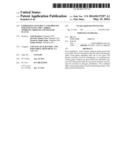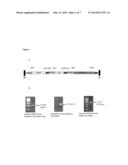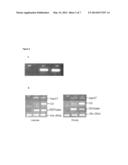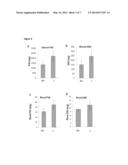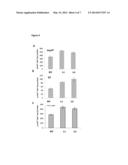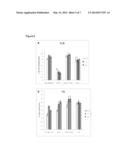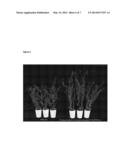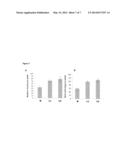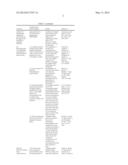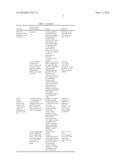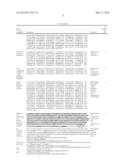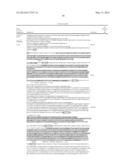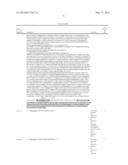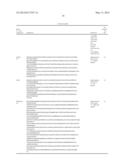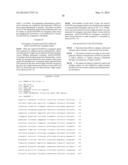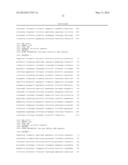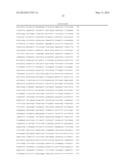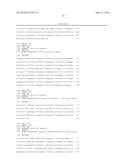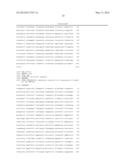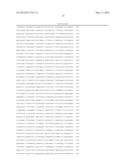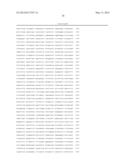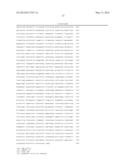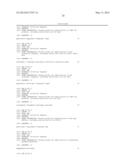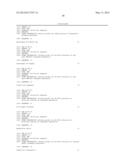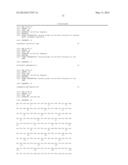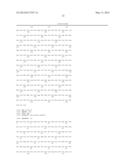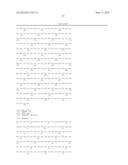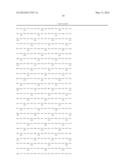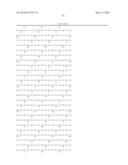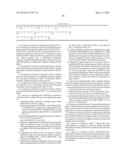Patent application title: EXPRESSION CONSTRUCT AND PROCESS FOR ENHANCING THE CARBON, NITROGEN, BIOMASS AND YIELD OF PLANTS
Inventors:
Anish Kaachra (Palampur, IN)
Surender Kumar Vats (Palampur, IN)
Paramvir Singh Ahuja (Palampur, IN)
Sanjay Kumar (Palampur, IN)
Assignees:
Council of Scientific and Industrial Research
IPC8 Class: AC12N1582FI
USPC Class:
800290
Class name: Multicellular living organisms and unmodified parts thereof and related processes method of introducing a polynucleotide molecule into or rearrangement of genetic material within a plant or plant part the polynucleotide alters plant part growth (e.g., stem or tuber length, etc.)
Publication date: 2014-05-15
Patent application number: 20140137297
Abstract:
The assimilated C and N largely influence plant growth and crop yields.
Previous attempts to alter the carbon and nitrogen status of the plants
attempted with one or two genes The present invention involves
simultaneous co-overexpression of three genes wherein one gene (PEPCase)
efficiently capture CO2 whereas the other two encode for enzymes (Asp AT
and GS) involved in nitrogen assimilation. The combined effect is the
enhancement of carbon and nitrogen status of the plant and the
productivity.Claims:
1. An expression construct represented by SEQ ID NO. 7 for co-expression
of the genes AspAT, GS and PEPCase comprising nucleotide sequences
represented by SEQ ID NO: 1, SEQ ID NO: 2 and SEQ ID NO: 3, wherein SEQ
ID NO: 1 represents AspAT gene, SEQ ID NO: 2 represents GS gene and SEQ
ID NO: 3 represents PEPCase gene linked to at least one control sequence
and a transcription terminator sequence, useful for enhancing the carbon,
nitrogen, biomass and yield of plants as compared to wild type or
untransformed plant.
2. An expression construct as claimed in claim 1, wherein the control sequence is represented by SEQ ID NO: 4 and the transcription terminator sequence is represented by SEQ ID NO: 5.
3. An expression construct as claimed in claim 1, wherein the said control sequence is a constitutive promoter selected from the group consisting of CaMV 35S promoter, rubisco promoter, ubiquitin promoter, actin promoter.
4. An expression construct as claimed in claim 1, wherein the terminator used is preferably selected from the group consisting of Nos terminator and CaMV 3'UTR.
5. An expression construct as claimed in claim 1, wherein the polynucleotide having SEQ ID No: 7 is overexpressed in plants.
6. A process for preparing the expression construct as claimed in claim 1, wherein the process comprising the steps of: i) amplifying cDNA sequences encoding genes represented by SEQ ID NO: 1 using primers represented by SEQ ID NO: 10 and SEQ ID NO: 11, SEQ ID NO: 2 using primers represented by SEQ ID NO: 8 and SEQ ID NO: 9 and SEQ ID NO: 3 using primers represented by SEQ ID NO: 12 and SEQ ID NO: 13; ii) cloning independently the amplified product of SEQ ID NO: 1, 2 and 3 as obtained in step (i) into pGEM-T easy vector; iii) digesting independently the plasmid from the positive clones as obtained in step (ii) along with pCAMBIA 1302 and further ligating the digested gene products and pCAMBIA 1302 and transforming into E. coli DH5 α cells; iv) sequencing the plasmid from the positive colonies obtained in step (iii) confirming the inframe cloning of AspAT::pCAMBIA1302; GS::pCAMBIA1302 and PEPCase::pCAMBIA 1302; v) amplifying the products obtained in step (iv) by using primers represented by SEQ ID NO: 10 and SEQ ID NO: 16; SEQ ID NO: 14 and SEQ ID NO: 15 and SEQ ID NO: 17 and SEQ ID NO: 18; vi) cloning, digesting, ligating and sequencing was again performed independently for the amplified GS coding sequence to form GS+pCAMBIA1302 which was further digested and ligated with the plasmids of positive clones of amplified AspAT coding sequence to form AspAT+GS+pCAMBIA1302 expression cassette; vii) ligating the digested plasmids of positive clones of amplified PEPCase coding sequence with the destination pCAMBIA1302 which was previously cloned with the AspAT+GS+ expression cassette as obtained in step (vi) such that the genes AspA, GS and PEPCase were controlled by independent CaMV 35S promoter and Nos transcriptional terminator to form single plant expression construct AspAT+GS+PEPCase represented by SEQ ID NO: 7.
7. A process for enhancing the carbon, nitrogen, biomass and yield of plants using the expression construct as claimed in claim 1, wherein the said process comprising the steps of: a) transforming Agrobacterium tumefacians strain with the expression construct as claimed in claim 1; b) transforming the explants with the recombinant Agrobacterium tumefacians strain as obtained in step (a); c) selecting the transformed explants of step (b) to obtain the desired transformed plants having enhanced level of carbon, nitrogen, biomass and yield of plants as compared to wild type plant.
8. A process as claimed in claim 7, wherein the transformed plants is selected from the group comprising of arabidopsis, tomato, potato, tobacco, maize, wheat, rice, cotton, mustard, pigeon pea, cowpea, pea, sugarcane, soyabean and sorghum.
9. A process as claimed in claim 7, wherein the transformed plants display an increase of about 45-50% in PEPCase activity, at least 55% in GS activity and 55-60% in AspAT activity as compared to wild type, resulting in increase in carbon and nitrogen levels in the plant.
10. A process as claimed in claim 7, wherein the transformed plants as compared to wild type display increased yield and/or biomass, indicated by increased seed yield and/or pod yield.
11. A process as claimed in claim 7, wherein the transformed plants display enhanced growth characteristics characterized by increased shoot fresh weight, shoot dry weight, root fresh and dry weight as compared to wild type or untransformed plant.
Description:
[0001] The following specification particularly describes the invention
and the manner in which it is to be performed:
FIELD OF THE INVENTION
[0002] The present invention relates to an expression construct for enhancing the carbon (C), nitrogen (N), biomass and yield of plants.
[0003] Further, the present invention provides the process for enhancement of C and N levels and subsequent improvement in the biomass and yield of plant by using the aforesaid expression construct which utilizes co-overexpression of genes from enzymes phosphoenolpyruvate carboxylase (hereinafter, referred as "PEPCase"), glutamine synthetase (hereinafter, referred as "GS") and aspartate aminotransferase (hereinafter, referred as "AspAT"). In particular, the present invention is directed to transgenic plants where nucleic acid sequences encoding the said proteins are expressed in plant cells. More particularly, the present invention relates to the transformation of a plant with genetic construct involving co-overexpression of three genes wherein one gene PEPCase encodes enzyme responsible to capture CO2 and the other two encode for enzymes (AspAT and GS) involved in N assimilation wherein the N assimilation requires C skeleton which is met by PEPCase, under the control of constitutive promoter comprising plant Arabidopsis thaliana transformed with AspAT+GS+PEPCase gene and expression of this gene in plants, thereby enhancing the status of C and N, biomass and yield of plant.
BACKGROUND OF THE INVENTION AND PRIOR ART
[0004] The present invention relates to a transformed plant with co-overexpression of three genes, viz.
[0005] AspAT, GS and PEPCase, leading to enhanced C, N content, biomass, and yield component. PEPCase (EC. 4.1.1.31) is a ubiquitous enzyme in plants that catalyses the β-carboxylation of phosphoenolpyruvate (hereinafter, referred as "PEP") in the presence of HCO3.sup.- and Mg2.sup.+ to yield oxaloacetate (hereinafter, referred as "OAA") and inorganic phosphate (hereinafter, referred as "Pi"), and it primarily has an anaplerotic function of replenishing the tricarboxylic acid cycle with intermediates. In higher plants, there are several isoforms of PEPCase of different organ specificities and they are involved in a variety of functions including stomata opening, fruit ripening and seed maturation. The leaves of C4 and CAM plants contain high levels of PEPCase, which catalyze the initial CO2 fixation of photosynthesis. The much lower levels of PEPCase seen in the leaves of C3 plants contribute to an anaplerotic function and play a role in regulation of the cellular pH.
[0006] GS (EC 6.3.1.2) catalyses the ATP-dependent condensation of ammonia (hereinafter, referred as "NH3") with glutamate (hereinafter, referred as "Glu") to produce glutamine (hereinafter, referred as "Gln"). Subsequently, glutamate synthase (GOGAT) transfers the amide group of Gln to α-ketoglutarate producing two molecules of Glu. Both Gln and Glu are the primary source of organic N for proteins, nucleic acid and chlorophyll.
[0007] AspAT (EC 2.6.1.1) catalyzes the reversible transfer of the amino group of asparate (hereinafter, referred as "Asp") to α-ketoglutarate to form OAA and Glu. In plants, AspAT has been proposed to play several metabolic roles including: recycling of C skeletons during NH3.sup.+ assimilation in roots, providing amide precursors for biosynthesis of major nitrogen transport molecules such as asparagines (hereinafter, referred as "Asn") and ureides, recruiting Asn nitrogen during seed filling and participating in intracellular C shuttles in C4 plants providing precursors for the biosynthesis of the Asp family of amino acids.
[0008] Plant performance in terms of biomass production, yield or harvest index depends upon number of internal and environmental factors. Among all these factors, plant C and N level is one of the important factors governing plant productivity. The emerging details of C and N assimilation suggest that a regulatory system coordinates the uptake and distribution of these nutrients in response to both metabolic and environmental cues. Plants sense changes in their C and N status and relay this information to the nucleus where changes in gene expression are brought about. Since plant growth and crop yield are largely influenced by the assimilated C and N, many attempts have been made in the past to engineer efficient C and N assimilation. However, there is no report yet which show significant improvement in the status of C, N, biomass and yield in plants.
[0009] Table 1 illustrates the status of information available on the various strategies to improve C and/or N and biomass in different plants.
TABLE-US-00001 TABLE 1 Transformation Functions System adopted Results Reference NAD kinase2 Arabidopsis NADK2 NADK2 overexpressors Takahashi, H., (NADK2) overexpressor and were characterized by Takahara, K., Catalyzes the nadk2 mutant were increase in calvin cycle Hashida, S., synthesis of studied to investigate intermediates and Hirabayashi, T., NADP from NAD the impact of altering amino acid like Glu Fujimori, T., in chloroplasts NADP level on plant and Gln. However, Yamada, M. K., metabolism. there is no clear Yamaya, T., evidence on role of Yanagisawa, S. NADK2 influencing C and Uchimiy, H. and N metabolism. 2009. Plant Physiol. 151: 100- 113. Dof 1 Maize Dof1 cDNA was Dof1 overexpression Yanagisawa, S., Dof1 is a overexpressed in in Arabidopsis has led Akiyama, A., transcription Arabidopsis plants to co-operative Kisaka, H., activator for under derivative of modification of plant C Uchimiya, H. and multiple gene the 35S promoter and N content, with Miwa, T. 2004. expressions designated as improved growth Proc. Natl. Acad. associated with 35SC4PPDK. under low N Sci. USA. 101: the organic acid conditions. However, 7833-7838 metabolism, effect of CN including alteration on plant PEPCase. biomass or yield was not discussed. GS i.) A soybean cytosolic Over expression of Vincent, R., GS catalyses the GS gene (GS15) fused cytosolic GS Fraisier, V., ATP- dependent with the constitutive accelerated plant Chaillou, S., condensation of CaMV 35S promoter in development, leading Limami, M. A., NH3 with (Glu) to order to direct its over- to early senescence Deleens, E., produce (Gln). expression in Lotus and premature Phillipson, B., corniculatus L. plants. flowering when grown Douat, C., NH4.sup.+ rich medium. Boutin, J.-P. and Limitation of C Hirel, B. skeleton and energy 1997. Planta. for enhanced NH4.sup.+ 201: 424-433. assimilation were anticipated. ii.) A pea cytosolic GS Overexpression of Oliveira, I.., gene was cytosolic GS in relation Brears, T., overexpressed in to N, light and Knight, T., Clark, tobacco plants photorespiration A. and Coruzzi, suggested an G. 2002, Plant alternative route to Physiol. chloroplastic GS for 129: 1170-1180 assimilation of photorespiratory ammonium. iii.) Full-length cDNAs An increased metabolic Cai, H., Zhou, Y., encoding rice cytosolic level in GS- Xiao, J., Li, X., GS genes (OsGS1;1 overexpressed plants Zhang, Q. and and OsGS1;2) along was obtained, which Lian, X. 2009, with E. coli GS gene showed higher total GS Plant Cell Rep. (glnA) were activities and soluble 28: 527-537 overexpressed in the protein concentrations rice plant under in leaves and higher constitutive CaMV 35S total amino acids and promoter. total N content in the whole plant. However, decrease in both grain yield production and total amino acids were observed in seeds of GS-overexpressed plants compared with wild-type plants. iv) cDNA encoding alfa Transgenic plants Fuentes, S., Allen, alfa cytosolic GS over grew better under N D., Ortiz-Lopez, A. expressed in tobacco starvation by and Hernandez, plants maintaining G. 2001. J. Exp. photosynthesis at rate Bot. 52: 1071- comparable to those 1081. of plants under high N, while photosynthesis in control plants was inhibited by 40-50%. These results further reflect the need for cooperative modification of CN metabolism for developing plants with better agronomic traits. PEPCase i) The intact maize Transgenic plants Agarie, S., Miura, PEPCase catalyses gene encoding C4- exhibited higher A., Sumikura, R., the β- specific PEPCase used PEPCase activity with Tsukamoto, S., carboxylation of for transformation of reduced O2 inhibition Nose, A., Arima, S., PEP in the rice plants of photosynthesis. It Matsuoka, M. and presence of HCO3.sup.- was found that the Tokutomi, M. M. and Mg2.sup.+ to yield reduced O2 inhibition 2002. Plant Sci. OAA and Pi. photosynthesis was 162: 257-265. primarily due to reduction of Pi rather than increase in the partial direct fixation of atmospheric CO2 via the enhanced maize PEPCase. However, no report on biomass accumulation or yield as a consequence of PEPCase overexpression was reported. ii) Maize PEPCase Higher levels of maize Hudspeth, introduced in to PEPCase transcript of R. L., Grula, tobacco plants under the correct size were J. W., Dai, Z., the control maize obtained using tobacco Edwards, G. E. and PEPCase and tobacco (chlorophyll a/b Ku, M. S. B. 1992. chlorophyll a/b binding protein gene Plant Physiol. 98: binding protein gene promoter. With two 458-464 promoter. fold incerase in PEPCase activities in leaf, transgenic plants had significantly elevated levels of titratable acidity and malic acid. However, these biochemical differences did not produce any significant physiological changes with respect to photosynthetic rate or CO2 compensation point. AspAT i) Panicum miliaceum mAspAT- or cAspAT- Sentoku, N., AspAT L. mitochondrial and transformed plants Taniguchi, M., catalyzes cytosolic AspAT had about threefold or Sugiyama, T., the reversible (mAspAT and cAspAT, 3.5-fold higher AspAT Ishimaru, K., transfer of the respectively) genes activity in Ohsugi, R., amino group of were expressed in the leaf than non- Takaiwa, F. and (Asp) to a- tobacco plants under transformed plants, Toki, S. 2000. ketoglutarate to CaMV 35S promoter. respectively. Plant Cell Rep. form OAA and Leaves of both 19: 598-603. Glu transformed plants had increased levels of PEPCase and transformed plants with cAspAT also had increased levels of mAspAT in the leaf. These results further suggested interaction between C and N metabolism. ii) Three AspAT genes Compared with Zhou. Y., Cai, H., from rice (OsAAT3) control Xiao, J. and one AspAT gene plants, the Li, X., Zhang, Q. from E. coli (EcAAT) transformants showed and Lian, X. 2009. were over expressed significantly increased Theor Appl under CaMV 35S leaf AspAT activity and Genet. 118: 1381- promoter in rice greater seed amino 1390 plants. acid and protein contents. However, influence of CN level on biomass or yield was not discussed.
[0010] Higher activity of PEPCase shall facilate CO2 capturing and makes the carbon backbone available for routing of nitrogen in to organic form through joint activity of AspAT and GS. As a result, the inventors have found that object of the present invention can be attained by concomitant increase in expression of genes encoding AspAT, GS and PEPCase to establish the present invention.
[0011] Below is given a state of the art knowledge in relation to the present invention and the attempts previously made to enhance either carbon and/or nitrogen levels in the plant. Reference may be made to article by Hudspeth, R. L., Grula, J. W., Dai, Z., Edwards, G. E. and Ku, M. S. B., entitled "Expression of miaze phosphoenolpyruvate carboxylase in transgenic tobacoo" (1992, Plant Physiology, 98: 458-464), wherein PEPCase from maize was expressed under a tobacco (Nicotiana plumbaginifolia) chlorophyll a/b binding protein gene promoter in tobacco plants. Up to two fold higher activity of PEPCase was observed in the transgenic leaves as compared to non-transformants with elevated levels of titratable acidity and malic acid. However, these biochemical differences did not produce any significant physiological changes with respect to photosynthetic rate or CO2 compensation point.
[0012] Reference may be made to article by Lebouteiller, B., Dupont, A. G., Pierre, J. N., Bleton, J., Tchapla, A., Maucourt, M. and Moing, A., Rolin, D., and Vidal, J. entitled "Physiological impacts of modulating phosphoenolpyruvate carboxylase levels in leaves and seeds of Arabidopsis thaliana" (2007, Plant Science, 172:256-272,), wherein the PEPCase of sorghum was expressed under CaMV 35S promoter in Arabidopsis plant. The leaves of the primary transformants showed up to ten-fold increase in PEPCase activity and up to 30% increase in the dry weight and total protein content of seeds. However, the transformants (primary and progeny) did not show any improved growth phenotype or modification in seed production per plant
[0013] Reference may be made to yet another article by Chen, L. M., Li, K. Z. Miwa, T. and Izui, K. entitled "Overexpression of a cyanobacterial phosphoenol pyruvate carboxylase with diminished sensitivity to feedback inhibition in Arabidopsis changes amino acid metabolism" (2004, Planta, 219: 440-419.), wherein the cyanobacterial Synechococcus vulcanus phosphoenolpyruvate carboxylase (SvPEPCase) with diminished sensitivity to feed back inhibition, was over expressed under the control of CaMV 35S promoter in Arabidopsis plant. One third of the T1 transformants showed severe phenotypes as bleached leaves and were infertile when grown on soil. However, no such phenotype was observed with Arabidopsis transformed with maize PEPCase (ZmPEPC) for C4 photosynthesis, which is normally sensitive to a feedback inhibitor, L-malate. The growth inhibition of SvPEPC transformed T2 plants was presumed to be primarily due to a decreased availability of phosphoenolpyruvate (PEP), one of the precursors for the shikimate pathway for the synthesis of aromatic amino acids and phenylpropanoids.
[0014] Reference may be made to yet another article by Fukayama, H., Hatch, M. D., Tamai, T., Tsuchida, H., Sudoh, S., Furbank, R. T. and Miyao, M., entitled "Activity regulation and physiological impacts of maize C (4)-specific phosphoenolpyruvate carboxylase overproduced in transgenic rice plants" (2003, Photosynthesis Research, 77: 227-239), wherein the intact maize PEPCase gene was overexpressed in the leaves of rice plants. Introduced PEPCase in transgenic rice leaves underwent activity regulation through protein phosphorylation in manner similar to endogenous rice PEPCase but contrary to that occurring in maize leaves, being downregulated in the light and upregulated in the dark. Compared with untransformed rice, the level of PEP was slightly lower and the product (OAA) was slightly higher in transgenic rice, suggesting that maize PEPCase was functioning even though it remained dephosphorylated and less active in the light. 14CO2 labeling experiments indicated that maize PEPCase did not contribute significantly to the photosynthetic CO2 fixation of transgenic rice plants. Rather, it slightly lowered the CO2 assimilation rate. This effect was ascribable to the stimulation of respiration in the light, which was more marked at lower O2 concentrations. It was concluded that overproduction of PEPCase does not directly affect photosynthesis significantly but it suppresses photosynthesis indirectly by stimulating respiration in the light.
[0015] Reference may be made to yet another article by Vincent, R., Fraisier, V., Chaillou, S., Limami, M. A., Deleens, E., Phillipson, B., Douat, C., Boutin, J. P. and Hirel, B., entitled "Overexpression of a soybean gene encoding cytosolic glutamine synthetase in shoots of transgenic Lotus corniculatus L. plants triggers changes in ammonium assimilation and plant development" (1997, Planta. 201:424-433), wherein a soyabean cytosolic GS gene GS15 was fused with CaMV 35S promoter to achieve constitutive expression in the lotus corniculatus L. plants. On growing the transgenic plants under different N regimes an increase in free amino acids and ammonium was observed accompanied by a decrease in soluble carbohydrates in the transgenic plants cultivated with 12 mM NH4+ in comparison to the wild type grown under the same conditions. Labelling experiments revealed that both ammonium uptake in the roots and the subsequent translocation of amino acids to the shoots was lower in plants over expressing GS. However the early floral development in the transformed plants suggested the role of GS in the early senescence and premature flowering when plants were grown on an ammonium-rich medium. Limitation of C skeleton and energy for enhanced NH4.sup.+ assimilation were anticipated.
[0016] Reference may be made to yet another article by Fuentes, S. I., Allen, D. J., Ortiz-Lopez, A. and Hernandez, G., entitled "Overexpression of cytosolic glutamine synthetase increases photosynthesis and growth at low nitrogen conditions" (2001, Journal of Experimental Botany, 52:1071-1081), wherein the alfa alfa GS driven by constitutive CaMV 35S promoter introduced into tobacco plants. Leaf GS activity in the transgenic plants increased up to six times of untrasformed plants. Under N starvation GS transgenic grew better by maintenance of photosynthesis at rates indistinguishable from plants under high N, while photosynthesis in the control plants was inhibited by 40-50% by N deprivation. However, under optimum N fertilization conditions, no effect of GS overexpression on photosynthesis or growth was observed.
[0017] Reference may be made to yet another article by Oliveira, I., Brears, T., Knight, T., Clark, A. and Coruzzi, G., entitled "Overexpression of cytosolic glutamine synthetase. Relation to nitrogen, light, and photorespiration" (2002, Plant Physiology, 129: 1170-1180), wherein the overexpression of pea cytosolic GS was studied in relation to nitrogen, light and photorespiration. Tobacco plants, which ectopically overexpress cytosolic GS1 in leaves, display a light-dependent improved growth phenotype under N-limiting and N-non-limiting conditions as evident by increase in fresh weight, dry weight, and leaf soluble protein. The cytosolic GS1 transgenic plants also exhibit an increase in the CO2 photorespiratory burst and an increase in levels of photorespiratory intermediates, suggesting changes in photorespiration. However, the effect of stimulation of photorespiration by GS overexression on plant productivity was not discussed.
[0018] Reference may be made to yet another article by Cai, H., Zhou, Y., Xiao, J., Li, X., Zhang, Q. and Lian, X., entitled "Overexpressed glutamine synthetase gene modifies nitrogen metabolism and abiotic stress response in rice" (2009, Plant Cell Reports. 28: 527-537), wherein the full-length cDNAs encoding rice (Oryza sativa) cytosolic GS genes (OsGS1;1 and OsGS1;2) along with E. coli GS gene (glnA) were overexpressed in the rice plant under constitutive CaMV 35S promoter. An increased metabolic level in GS-overexpressed plants was obtained, which showed higher total GS activities and soluble protein concentrations in leaves and higher total amino acids and total N content in the whole plant. However, decrease in both grain yield production and total amino acids were observed in seeds of GS-overexpressed plants compared with wild-type plants.
[0019] Reference may be made to yet another article by Sentoku, N., Taniguchi, M., Sugiyama, T., Ishimaru, K., Ohsugi, R., Takaiwa, F. and Toki, S., entitled "Analysis of the transgenic tobacco plants expressing Panicum miliaceum aspartate aminotransferase genes" (2000, Plant Cell Reports, 19: 598-603), wherein the effects of the overexpression of Panicum mitochondrial and cytoplasmic AspAT (mAspAT and cAspAT respectively) under the control of CaMV 35S promoter were evaluated on transgenic tobacco plants. The mAspAT- or cAspAT-transformed plants had about threefold or 3.5-fold higher AspAT activity in the leaf than non-transformed plants, respectively. Interestingly, the leaves of both transformed plants had increased levels of PEPCase and transformed plants with cAspAT also had increased levels of mAspAT in the leaf. These results suggest that the increased expression of Panicum cAspAT in transgenic tobacco enhances the expression of its endogenous mAspAT and PEPCase, and the increased expression of Panicum mAspAT enhances the expression of its endogenous PEPCase. However, there is no account on effect of AspAT overexpression on plant growth and productivity.
[0020] Reference may be made to yet another article by Zhou, Y., Cai, H., Xiao, J., Li, X., Zhang, Q. and Lian, X., entitled "Over-expression of aspartate aminotransferase genes in rice resulted in altered nitrogen metabolism and increased amino acid content in seeds" (2009, Theoretical and Applied Genetics, 118:1381-1390), wherein three AspAT genes from rice (OsAAT1-3) encoding chloroplastic, cytoplasmic, and mitochondrial AspAT isoenzymes, respectively and one AspAT gene from E. coli (EcAAT) were overexpressed in rice plant under the control of CaMV 35S promoter. The OsAAT1, OsAAT2, and EcAAT transformants showed significantly increased leaf AspAT activity and greater seed amino acid and protein contents. However no significant changes were found in leaf AspAT activity, seed amino acid content or protein content in OsAAT3 over-expressed plants.
[0021] Reference may be made to yet another article by Murooka, Y., Mori, Y. and Hayashi, M., entitled "Variation of the amino acid content of Arabidopsis seeds by expressing soyabean aspartate aminotransferase gene" (2009, Journal of Bioscience and Bioengineering, 94: 225-230), wherein AspAT5 encoding the chloroplast AspAT from Soyabean was linked to CaMV 35S promoter for achieving its overexpression in the Arabidopsis plant. Expression of AspAT5 in transformants caused 3-, 4-, 23-, and 50-fold increases in the contents of free glycine, alanine, asparagine, and Glu, respectively, in the T3 seeds. However, a decrease in the contents of valine, tyrosine, isoleucine, leucine, and phenylalanine by several folds was also observed. Further, there is no report on effect of overexpression of AspAt on plant growth and productivity.
[0022] Reference may be made to yet another article by Yanagisawa, S., Akiyama, A., Kawaka, H., Uchimiya, H. and Miwa, T. entitled "Metabolic engineering with Dof1 transcription factor in plants: Improved nitrogen assimilation and growth under low-nitrogen conditions" (2004, Proceedings of the National Academy of Sciences (USA), 101:7833-7838), wherein over-expression of Dof1 transcription factor from maize improves N assimilation in transgenic Arabidopsis plants. Dof1 expressing plants showed up-regulation of genes encoding enzymes for C skeleton production, a marked increase of amino acid contents, and a reduction of the glucose level. The results suggest cooperative modification of C and N metabolisms on the basis of their intimate link. Elementary analysis revealed that the N content increased in the Dof1 transgenic plants (≈30%), indicating promotion of net N assimilation. However, effect of C N alteration on plant biomass or yield was not discussed.
[0023] Reference may be made to still another article by Takahashi, H., Takahara, K., Hashida, S., Hirabayashi, T., Fujimori, T., Kawai-Yamada, M., Yamaya, T., Yanagisawa, S, and Hirofumi Uchimiya, H., entitled "Pleiotropic Modulation of carbon and nitrogen metabolism in Arabidopsis plants overexpressing the NAD kinase2 gene" by (2009, Plant Physiology. 151:100-113), wherein transgenic Arabidopsis plants with over expression of NAD kinase2 (NADK2) along with NADK2 mutants were raised to investigate the impacts of altering NADP level on plant metabolism. Metabolite profiling revealed that NADP(H) concentrations were proportional to NADK activity in NADK2 overexpressors and in the NADK2 mutant. Several metabolites associated with the calvin cycle were also higher in the overexpressors, accompanied by an increase in overall Rubisco activity. Furthermore, enhanced NADP(H) production due to NADK2 overexpression increased N assimilation. Gln and Glu concentrations, as well as some other amino acids, were higher in the overexpressors. However, there is no clear evidence on role of NADK2 influencing C and N metabolism.
[0024] The improvement in the C and N status of plants is a major concern to improve productivity. However, there is no report yet which show enhancement of C and N levels and subsequent improvement in the biomass and yield of plant.
[0025] Further, no attempt has been made to co-over express three genes, viz. AspAT, GS and PEPCase, leading to enhanced status of C and N, biomass, and yield.
OBJECTIVES OF THE INVENTION
[0026] The main objective of the present invention is to provide an expression construct for enhancing the carbon, nitrogen, biomass and yield of plants which obviates the drawbacks of the hitherto known prior art as detailed above.
[0027] Another objective of the present invention is to provide an expression construct for co-overexpression of AspAT (SEQ ID NO: 1), GS (SEQ ID NO: 2). and PEPcase (SEQ ID NO: 3) wherein PEPCase efficiently captures CO2 whereas the other two genes encoding for enzymes (AspAT and GS) have role in N assimilation, using the carbon backbone provided by PEPCase mediated reaction resulting in the enhancement of C and N status with improved biomass and yield of plants.
[0028] Yet another objective of the present invention is to raise transgenic plant exhibiting co-overexpression of genes AspAT, GS and PEPCase.
[0029] Still another objective of the present invention is to evaluate the expression of AspAT, GS and PEPCase genes in transgenic plants.
[0030] Still another objective of the present invention is to evaluate the transgenic plants for status of C and N, biomass and yield compared to wild plants.
SUMMARY OF THE INVENTION
[0031] Accordingly, the present invention provides an expression construct represented by SEQ ID NO. 7 for co-expression of the genes AspAT, GS and PEPCase comprising nucleotide sequences represented by SEQ ID NO: 1, SEQ ID NO: 2 and SEQ ID NO: 3, wherein SEQ ID NO: 1 represents AspAT genes, SEQ ID NO: 2 represents GS genes and SEQ ID NO: 3 represents PEPCase genes linked to at least one control sequence and a transcription terminator sequence, useful for enhancing the carbon, nitrogen, biomass and yield of plants as compared to wild type or untransformed plant.
[0032] In an embodiment of the present invention, the control sequence is preferably represented by SEQ ID NO: 4.
[0033] In another embodiment of the present invention, the transcription terminator sequence is represented by SEQ ID NO: 5.
[0034] In an embodiment, the present invention provides an expression construct prepared from the cytosolic AspATgene from soyabean, cytosolic GS gene from tobacoo and cytosolic PEPCase gene from maize.
[0035] In another embodiment of the present invention, the polynucleotide having SEQ ID No: 7 is overexpressed in plants.
[0036] In still another embodiment of the present invention, the control sequence used is a constitutive promoter selected from the group consisting of CaMV 35S promoter, rubisco promoter, ubiquitin promoter, actin promoter.
[0037] In still another embodiment of the present invention, the terminator used is preferably selected from the group consisting of Nos terminator and CaMV 3' UTR.
[0038] In still another embodiment of the present invention, a process for preparing the expression construct wherein the process comprising the steps of:
[0039] i) amplifying cDNA sequences encoding genes represented by SEQ ID NO: 1 using primers represented by SEQ ID NO: 10 and SEQ ID NO: 11, SEQ ID NO: 2 using primers represented by SEQ ID NO: 8 and SEQ ID NO: 9 and SEQ ID NO: 3 using primers represented by SEQ ID NO: 12 and SEQ ID NO: 13;
[0040] ii) cloning independently the amplified product of SEQ ID NO: 1, 2 and 3 as obtained in
[0041] step (i) into pGEM-T easy vector;
[0042] iii) digesting independently the plasmid from the positive clones as obtained in step (ii) along with pCAMBIA 1302 and further ligating the digested gene products and pCAMBIA 1302 and transforming into E. coli DH5 α cells;
[0043] iv) sequencing the plasmid from the positive colonies obtained in step (iii) confirming the inframe cloning of AspAT::pCAMBIA1302; GS::pCAMBIA1302 and PEPCase::pCAMBIA 1302.
[0044] v) amplifying the products obtained in step (iv) by using primers represented by SEQ ID NO: 10 and SEQ ID NO: 16; SEQ ID NO: 14 and SEQ ID NO: 15 and SEQ ID NO: 17 and SEQ ID NO: 18.
[0045] vi) cloning, digesting, ligating and sequencing was again performed independently for the amplified GS coding sequence to form GS+pCAMBIA1302 which was further digested and ligated with the plasmids of positive clones of amplified AspAT coding sequence to form AspAT+GS+pCAMBIA1302 expression cassette;
[0046] vii) ligating the digested plasmids of positive clones of amplified PEPCase coding sequence with the destination pCAMBIA1302 which was previously cloned with the AspAT+GS+ expression cassette as obtained in step (vi) such that the genes AspA, GS and PEPCase were controlled by independent CaMV 35S promoter and Nos transcriptional terminator to form single plant expression construct AspAT+GS+PEPCase represented by SEQ ID NO: 7.
[0047] In still another embodiment of the present invention, a process for enhancing the carbon, nitrogen, biomass and yield of plants using the expression construct, wherein the said process comprising the steps of:
[0048] a) transforming Agrobacterium tumefacians strain with the expression construct as claimed in claim 1;
[0049] b) transforming the explants with the recombinant Agrobacterium tumefacians strain as obtained in step (a);
[0050] c) selecting the transformed explants of step (b) to obtain the desired transformed plants having enhanced level of carbon, nitrogen, biomass and yield of plants as compared to wild type plant.
[0051] In still another embodiment of the present invention, a process wherein the transformed plants display an increase of about 45-50% in PEPCase activity, at least 55% in GS activity and 55-60% in AspAT activity as compared to wild type, resulting in increase in carbon and nitrogen levels in the plant.
[0052] In another embodiment of the present invention, the Agrobacterium strain provided is selected from a group consisting of GV3101 with ATCC number Agrobacterium tumefaciens (GV3101 (pMP90RK) (C58 derivative) ATCC® Number: 33970 Reference: Hayashi H, Czaja I, Lubenow H, Schell J, Walden R. 1992.
[0053] In yet another embodiment of the present invention, the transformed plants are selected from the group consisting of grain crops, pulses, vegetable crops, oilseed crop and ornamentals.
[0054] In yet another embodiment, the transformed plants are selected from the group consisting of arabidopsis, tomato, potato, tobacco, maize, wheat, rice, cotton, mustard, pigeon pea, cowpea, pea, sugarcane, soya bean and sorghum.
[0055] In still another embodiment, the transformed plants as compared to wild type display increased yield and/or biomass, indicated by increased seed yield and/or pod yield.
[0056] In still another embodiment, the transformed plants display enhanced growth characteristics characterized by increased shoot fresh weight, shoot dry weight, root fresh and dry weight as compared to wild type or untransformed plant.
[0057] In yet another embodiment of the present invention, the transformed plant shows enhanced levels of carbon, nitrogen, biomass and yield as compared to wild plants.
[0058] In still another embodiment of the present invention, the expression and functionality of over expressed enzymes in transgenic plants is evaluated.
[0059] In yet another embodiment of the present invention, the selectable marker used is hpt gene (hygromycin phosphotransferase) represented by SEQ ID NO: 6 for hygromycin resistance controlled by duplicated CaMV 35S promoter and terminated by CaMV 3'UTR (polyA signal).
[0060] In another embodiment of the present invention, biochemical assays and RT-PCR were performed to evaluate the expression of introduced genes and the functionality of over expressed enzymes in transgenic plants.
[0061] In a further embodiment of the present invention, the transgenic plants were investigated for different growth and yield parameters and compared to wild plants cultivated under the same conditions.
BRIEF DESCRIPTION OF THE ACCOMPANYING DRAWINGS
[0062] FIG. 1 represents a schematic view of T-DNA region of plant transformation vector pCAMBIA1302 for co-overexpression of AspAT, GS and PEPCase (a) and amplification of coding sequences for AspAT, GS and PEPCase from respective plant sources (b) as discussed in Examples 1 to 4.
[0063] FIG. 2 represents DNA analysis (a) and RNA analysis (b) of WT, L1 and L2, where WT=wild; L1 and L2=two different transgenic lines co-overexpressing AspAT, GS and PEPCase.
[0064] FIG. 3 represents shoot fresh weight (FW) (a), shoot dry weight (DW) (b), root fresh weight (c) and root dry weight (d) of WT and AspAT+GS+PEPCase transgenic plants at 60 days of sowing. Data is mean of five separate biological replicates with standard deviation marked on each bar.
[0065] FIG. 4 represents AspAT activity (a) GS activity (b) and PEPCase activity (d) of WT, L1 and L2 at 42 days of sowing. Data is mean of three separate biological replicates with standard deviation marked on each bar.
[0066] FIG. 5 represents Analyses of N (a) and C (b) content from different plant parts of WT, L1 and L2 lines at 65 days of sowing. Data is mean of three separate biological replicates with standard deviation marked on each bar.
[0067] FIG. 6 represents a representative WT and AspAT+GS+PEPCase transgenic plants at 75 days of sowing.
[0068] FIG. 7 represents pod number (a) and seed yield (b) in WT, L1 and L2 at 75 days of sowing. Data is mean of five separate biological replicated with standard deviation marked on each bar.
DETAILED DESCRIPTION OF THE INVENTION
[0069] The present invention relates to genetic engineering of C and N metabolism in plants. In particular, the present invention relates to an expression construct for co-overexpression of AspAT, GS and PEPCase for concomitant alteration in the enzymes involved in C and N assimilation or utilization and/or their expression in order to engineer plants with increased C and N levels thereby promoting better growth and biomass production and enhanced yield.
[0070] The term "vector" refers to a construct made up of nucleic acids wherein gene from a foreign source can be ligated and isolated when needed. The construct is usually a plasmid (i.e. extra chromosomal self replicating nucleic acid) and is propagated, for example bacterial cell of E. coli. The vector in the present invention was used to transfer the gene from one source to another.
[0071] The term "gene" refers to the sequence of nucleic acids that can produce a polypeptide chain.
[0072] The term "gene expression" refers to the level/amount of RNA (i.e. sequence of ribonucleic acid) of choice transcribed (i.e. the process of synthesis of RNA by DNA) by DNA (i.e. sequence of deoxyribonucleic acid). When the gene was transcribed in higher amounts as compared to the control, it was referred to as "over-expression" of gene.
[0073] The term "selectable marker" refers to a gene, which allows a cell to survive in the presence of an otherwise toxic antibiotic
[0074] The term "transgenic plant" refers to genetically transformed plants with stable integration of introduced gene in to its genome The term "promoter" refers to the specific DNA sequence, usually located upstream (5') to the DNA sequence involved in transcription, wherein the enzyme RNA polymerase binds for the process of transcription. "Constitutive promoters" direct expression of the gene in all tissues and during all periods regardless of the surrounding environment and development stage of the organism.
[0075] The term `expression cassettes" refers to vector comprising of (a) a constitutive promoter; (b) all the three genes cloned 3' to the constitutive promoter, (c) a polyadenylation signal located 3' to the coding sequence.
[0076] and capable of passing genetic information on to successive generations.
[0077] `Wild-type" plants are untransformed plants.
[0078] The term "T0" refers to the first set of genetically transformed plants that can be identified and selected upon growth in presence of a selection agent antibiotic, for which the transgenic plant contains the corresponding resistance gene. The term "T1" refers to the generation of plants obtained after self-fertilization of the flowers of T0 generation plants, previously selected as being transgenic. "T2" plants are generated from T1 plants, and so on. The present invention will be illustrated in greater details by the following examples.
EXAMPLES
[0079] The following examples are given by way of illustration of the present invention and therefore should not be construed to limit the scope of the present invention.
[0080] Sequences of the primers used in the present invention are listed as follows:
TABLE-US-00002 Se- Name quence of the ID sequence Sequence Purpose No. AspAT atggcttctc acgacagcat ctccgcttct ccaacctccg cttctgattc cgtcttcaat 60 Represents 1 cDNA cacctcgttc gtgctcccga agatcctatc ctcggggtaa ctgtcgctta taacaaagat 120 nucleotide sequence ccaagtccag ttaagctcaa cttgggagtt ggtgcttacc gaactgagga aggaaaacct 180 sequences cttgttttga atgtagtgag gcgagttgaa cagcaactca taaatgacgt gtcacgcaac 240 of AspAT aaggaatata ttccgatcgt tgggcttgct gattttaata aattgagtgc taagcttatt 300 genes tttggggctg acagccctgc tattcaagac aacagggtta ccactgttca atgcttgtct 360 for ggaactggtt ctttaagagt tgggggtgaa tttttggcta aacactatca ccaacggact 420 making atatacttgc caacaccaac ttggggcaat cacccgaagg ttttcaactt agcaggcttg 480 an tctgtcaaaa cataccgcta ctatgctcca gcaacacgag gacttgactt tcaaggactt 540 expression ctggaagacc ttggttctgc tccatctgga tctattgttt tgctacatgc atgcgcacat 600 aaccccactg gtgtggatcc aacccttgag caatgggagc agattaggca gctaataaga 660 tcaaaagctt tgttaccttt ctttgacagt gcttatcagg gttttgctag tggaagtcta 720 gatgcagatg cccaacctgt tcgtttgttt gttgctgatg gaggcgaatt gctggtagca 780 caaagctatg caaagaatct gggtctttat ggggaacgtg ttggcgcctt aagcattgtc 840 tgcaagtcag ctgatgttgc aagcagggtt gagagccagc tgaagctagt gattaggccc 900 atgtactcaa gtcctcccat tcatggtgca tccattgtgg ctgccattct caaggaccgg 960 aatttgttca atgactggac tattgagttg aaggcaatgg ctgatcgcat catcagtatg 1020 cgccaagaac ttttcgatgc tttatgttcc agaggcacac ctggcgattg gagtcacatt 1080 atcaaacaga ttggaatgtt tactttcact ggattgaatg cggaacaagt ttccttcatg 1140 actaaagagt tccatatata catgacatct gatgggagga ttagcatggc tggtctgagt 1200 tccaaaactg tcccacttct ggcggatgcg atacatgcag ctgtaacccg agttgtctaa 1260 GS atggctcatc tttcagatct cgttaatctc aatctctctg actccactca gaaaattatt 60 Represents 2 cDNA gctgaataca tatggattgg tggatcagga atggacgtca ggagcaaagc cagaacactt 120 nucleotide sequence tctggacctg ttgatgatcc ttcaaagctt cccaaatgga attatgatgg ttctagcaca 180 sequences ggacaagctc ctggagaaga cagtgaagag atcctatatc ctcaagcaat tttcaaggat 240 of GS ccattcagaa ggggcaacaa tatcttggtc atttgtgatt gttacacccc agctggtgaa 300 genes cccattccaa caaacaaaag gcacagtgct gccaagattt tcagccaccc tgatgttgtt 360 for gttgaggaac cctggtatgg tcttgagcaa gaatacacct tgttgcaaaa agatatcaat 420 making tggcctcttg gatggcctct tggtggtttt cctggaccac agggaccata ctattgcgga 480 an attggagctg gaaaggtctt tggacgcgat atcgttgact ctcattataa ggcatgtctc 540 expression tatgctggga ttaacatcag tggtatcaat ggagaagtga tgcccggaca gtgggaattt 600 construct caagttggac cttcagttgg catttcagca gctgatgaat tgtgggcagc tcgttacatt 660 cttgagagga ttactgagat tgctggagtt gtggtctcat ttgaccccaa acctattccg 720 ggtgactgga atggtgctgg agctcacaca aactacagca caaagtctat gaggaatgaa 780 ggaggctatg aagtcattaa gaaggcaatt gagaaccttg gactgaggca caaggagcat 840 attgcagcat atggtgaagg caacgagcgt cgtctcactg gaagacacga aacagctgac 900 atcaacacat tcaaatgggg agttgcgaac cgtggtgcat ctattcgtgt gggaagagac 960 acggagagag aagggaaggg atacttcgag gataggaggc ctgcttcgaa tatggatcca 1020 ttcgtcgtga cttccatgat tgctgagacc actatcctat ccgagccttg a 1071 PEPCase ctcgtcgacc gcttcctcaa catcctccag gacctccacg ggcccagcct tcgcgaattt 180 Represents 3 cDNA gtccaggagt gctacgaggt ctcagccgac tacgagggca aaggagacac gacgaagctg 240 nucleotide sequence ggcgagctcg gcgccaagct cacggggctg gcccccgccg acgccatcct cgtggcgagc 300 sequences tccatcctgc acatgctcaa cctcgccaac ctggccgagg aggtgcagat cgcgcaccgc 360 of cgccgcaaca gcaagctcaa gaaaggtggg ttcgccgacg agggctccgc caccaccgag 420 PEPCase tccgacatcg aggagacgct caagcgcctc gtgtccgagg tcggcaagtc ccccgaggag 480 genes gtgttcgagg cgctcaagaa ccagaccgtc gacctcgtct tcaccgcgca tcctacgcag 540 for tccgcccgcc gctcgctcct gcaaaaaaat gccaggatcc gaaattgtct gacccagctg 600 making aatgccaagg acatcactga cgacgacaag caggagctcg atgaggctct gcagagagag 660 an atccaagcag ccttcagaac cgatgaaatc aggagggcac aacccacccc gcaggccgaa 720 expression atgcgctatg ggatgagcta catccatgag actgtatgga agggtgtgcc taagttcttg 780 construct cgccgtgtgg atacagccct gaagaatatc ggcatcaatg agcgccttcc ctacaatgtt 840 tctctcattc ggttctcttc ttggatgggt ggtgaccgcg atggaaatcc aagagttacc 900 ccggaggtga caagagatgt atgcttgctg gccagaatga tggctgcaaa cttgtacatc 960 gatcagattg aagagctgat gtttgagctc tctatgtggc gctgcaacga tgagcttcgt 1020 gttcgtgccg aagagctcca cagttcgtct ggttccaaag ttaccaagta ttacatagaa 1080 ttctggaagc aaattcctcc aaacgagccc taccgggtga tactaggcca tgtaagggac 1140 aagctgtaca acacacgcga gcgtgctcgc catctgctgg cttctggagt ttctgaaatt 1200 tcagcggaat cgtcatttac cagtatcgaa gagttccttg agccacttga gctgtgctac 1260 aaatcactgt gtgactgcgg cgacaaggcc atcgcggacg ggagcctctt ggacctcctg 1320 cgccaggtgt tcacgttcgg gctctccctg gtgaagctgg acatccggca ggagtcggag 1380 cggcacaccg acgtgatcga cgccatcacc acgcacctcg gcatcgggtc gtaccgcgag 1440 tggcccgagg acaagaggca ggagtggctg ctgtcggagc tgcgaggcaa gcgcccgctg 1500 ctgcccccgg accttcccca gaccgacgag atcgccgacg tcatcggcgc gttccacgtc 1560 ctcgcggagc tcccgcccga cagcttcggc ccctacatca tctccatggc gacggccccc 1620 tcggacgtgc tcgccgtgga gctcctgcag cgcgagtgcg gcgtgcgcca gccgctgccc 1680 gtggtgccgc tgttcgagag gctggccgac ctgcagtcgg cgcccgcgtc cgtggagcgc 1740 ctcttctcgg tggactggta catggaccgg atcaagggca agcagcaggt catggtcggc 1800 tactccgact ccggcaagga cgccggccgc ctgtccgcgg cgtggcagct gtacagggcg 1860 caggaggaga tggcgcaggt ggccaagcgc tacggcgtca agctcacctt gttccacggc 1920 cgcggaggca ccgtgggcag gggtggcggg cccacgcacc ttgccatcct gtcccagccg 1980 ccggacacca tcaacgggtc catccgtgtg acggtgcagg gcgaggtcat cgagttctgc 2040 ttcggggagg agcacctgtg cttccagact ctgcagcgct tcacggccgc cacgctggag 2100 cacggcatgc acccgccggt ctctcccaag cccgagtggc gcaagctcat ggacgagatg 2160 gcggtcgtgg ccacggagga gtaccgctcc gtcgtcgtca aggaggcgcg cttcgtcgag 2220 tacttcagat cggctacacc ggagaccgag tacgggagga tgaacatcgg cagccggcca 2280 gccaagagga ggcccggcgg cggcatcacg accctgcgcg ccatcccctg gatcttctcg 2340 tggacccaga ccaggttcca cctccccgtg tggctgggag tcggcgccgc attcaagttc 2400 gccatcgaca aggacgtcag gaacttccag gtcctcaaag agatgtacaa cgagtggcca 2460 ttcttcaggg tcaccctgga cctgctggag atggttttcg ccaagggaga ccccggcatt 2520 gccggcttgt atgacgagct gcttgtggcg gaagaactca agccctttgg gaagcagctc 2580 agggacaaat acgtggagac acagcagctt ctcctccaga tcgctgggca caaggatatt 2640 cttgaaggcg atccattcct gaagcagggg ctggtgctgc gcaaccccta catcaccacc 2700 ctgaacgtgt tccaggccta cacgctgaag cggataaggg accccaactt caaggtgacg 2760 ccccagccgc cgctgtccaa ggagttcgcc gacgagaaca agcccgccgg actggtcaag 2820 ctgaacccgg cgagcgagta cccgcccggc ctggaagaca cgctcatcct caccatgaag 2880 ggcatcgccg ccggcatgca gaacactggc tag 2913 CaMV 35S catggagtca aagattcaaa tagaggacct aacagaactc gccgtaaaga ctggcgaaca 60 Represents 4 promoter gttcatacag agtctcttac gactcaatga caagaagaaa atcttcgtca acatggtgga 120 control sequence gcacgacaca cttgtctact ccaaaaatat caaagataca gtctcagaag accaaagggc 180 sequence aattgagact tttcaacaaa gggtaatatc cggaaacctc ctcggattcc attgcccagc 240 tatctgtcac tttattgtga agatagtgga aaaggaaggt ggctcctaca aatgccatca 300 ttgcgataaa ggaaaggcca tcgttgaaga tgcctctgcc gacagtggtc ccaaagatgg 360 acccccaccc acgaggagca tcgtggaaaa agaagacgtt ccaaccacgt cttcaaagca 420 agtggattga tgtgatatct ccactgacgt aagggatgac gcacaatccc actatccttc 480 gcaagaccct tcctctatat aaggaagttc atttcatttg gagagaacac gggggact 538 nos cgttcaaaca tttggcaata aagtttctta agattgaatc ctgttgccgg tcttgcgatg 60 Represents 5 (nopaline attatcatat aatttctgtt gaattacgtt aagcatgtaa taattaacat gtaatgcatg 120 tran- synthase) acgttattta tgagatgggt ttttatgatt agagtcccgc aattatacat ttaatacgcg 180 scription 3'UTR atagaaaaca aaatatagcg cgcaaactag gataaattat cgcgcgcggt gtcatctatg 240 terminator (poly- sequence Asignal) sequence hygro- ctatttcttt gccctcggac gagtgctggg gcgtcggttt ccactatcgg cgagtacttc 60 Represents 6 mycin- tacacagcca tcggtccaga cggccgcgct tctgcgggcg atttgtgtac gcccgacagt 120 hpt gene phospho- cccggctccg gatcggacga ttgcgtcgca tcgaccctgc gcccaagctg catcatcgaa 180 (hygro- trans- attgccgtca accaagctct gatagagttg gtcaagacca atgcggagca tatacgcccg 240 mycin ferase gagtcgtggc gatcctgcaa gctccggatg cctccgctcg aagtagcgcg tctgctgctc 300 phospho- catacaagcc aaccacggcc tccagaagaa gatgttggcg acctcgtatt gggaatcccc 360 trans- gaacatcgcc tcgctccagt caatgaccgc tgttatgcgg ccattgtccg tcaggacatt 420 ferase) gttggagccg aaatccgcgt gcacgaggtg ccggacttcg gggcagtcct cggcccaaag 480 for catcagctca tcgagagcct gcgcgacgga cgcactgacg gtgtcgtcca tcacagtttg 540 hygromycin ccagtgatac acatggggat cagcaatcgc gcatatgaaa tcacgccatg tagtgtattg 600 resistance accgattcct tgcggtccga atgggccgaa cccgctcgtc tggctaagat cggccgcagc 660 gatcgcatcc atagcctccg cgaccggttg tagaacagcg ggcagttcgg tttcaggcag 720 gtcttgcaac gtgacaccct gtgcacggcg ggagatgcca taggtcaggc tctcgctaaa 780 ctccccaatg tcaagcactt ccggaatcgg gagcgcggcc gatgcaaagt gccgataaac 840 ataacgatct ttgtagaaac catcggcgca gctatttacc cgcaggacat atccacgccc 900 tcctacatcg aagctgaaag cacgagattc ttcgccctcc gagagctgca tcaggtcgga 960 gacgctgtcg aacttttcga tcagaaactt ctcgacagac gtcgcggtga gttcaggctt 1020 tttcat 1026 express- catggagtcaaagattcaaatagaggacctaacagaactcgccgtaaagactggcgaacagttca- taca Represents 7 ion gagtctcttacgactcaatgacaagaagaaaatcttcgtcaacatggtggagcacgacacacttgtcta- ct an cassettes ccaaaaatatcaaagatacagtctcagaagaccaaagggcaattgagacttttcaacaaagggt- aatatc expression for cggaaacctcctcggattccattgcccagctatctgtcactttattgtgaagatagtggaaaaggaagg- tgg construct AspAT, ctcctacaaatgccatcattgcgataaaggaaaggccatcgttgaagatgcctctgccgacagtgg- tccca for GS and aagatggacccccacccacgaggagcatcgtggaaaaagaagacgttccaaccacgtcttcaaagca- ag co- PEPCase tggattgatgtgatatctccactgacgtaagggatgacgcacaatcccactatccttcgcaagacc- ct expression coding ##STR00001## of se- gcttctcacgacagcatctccgcttctccaacctccgcttctgattccgtcttcaatcacctcgttcgtg the genes quences, ctcccgaagatcctatcctcggggtaactgtcgcttataacaaagatccaagtccagttaagctc- aacttggg AspAT, cloned agttggtgcttaccgaactgaggaaggaaaacctcttgttttgaatgtagtgaggcgagttgaaca- gcaact GS and under cataaatgacgtgtcacgcaacaaggaatatattccgatcgttgggcttgctgattttaataaattga- gtgct PEPCase control aagcttatttttggggctgacagccctgctattcaagacaacagggttaccactgttcaatgctt- gtctggaac SpeI of tggttctttaagagttgggggtgaatttttggctaaacactatcaccaacggactatatacttgccaacac- caa CamV 35S cttggggcaatcacccgaaggttttcaacttagcaggcttgtctgtcaaaacataccgctactat- gctccagc promoter aacacgaggacttgactttcaaggacttctggaagaccttggttctgctccatctggatctattg- ttttgctaca ( ) tgcatgcgcacataaccccactggtgtggatccaacccttgagcaatgggagcagattaggcagctaat- aag and atcaaaagctttgttacctttctttgacagtgcttatcagggttttgctagtggaagtctagatgcagat- gccca Nos acctgttcgtttgtttgttgctgatggaggcgaattgctggtagcacaaagctatgcaaagaatctgggt- cttt termin- atggggaacgtgttggcgccttaagcattgtctgcaagtcagctgatgttgcaagcagggttgaga- gccagc ator tgaagctagtgattaggcccatgtactcaagtcctcccattcatggtgcatccattgtggctgccattc- tcaag ( ) in gaccggaatttgttcaatgactggactattgagttgaaggcaatggctgatcgcatcatcagtatgc- gccaag pCAMBIA aacttttcgatgctttatgttccagaggcacacctggcgattggagtcacattatcaaacagattg- gaatgttt 1302 actttcactggattgaatgcggaacaagtttccttcatgactaaagagttccatatatacatgacatct- gatgg PrnII gaggattagcatggctggtctgagttccaaaactgtcccacttctggcggatgcgatacatgcagctgtaacc ##STR00002## ##STR00003## ctgttgccggtcttgcgatgattatcatataatttctgttgaattacgttaagcatgtaataattaacatgta- a tgcatgacgttatttatgagatgggtttttatgattagagtcccgcaattatacatttaatacgcgatagaaa acaaaatatagcgcgcaaactaggataaattatcgcgcgcggtgtcatctatgt ##STR00004## gccttcagtttagcttcatggagtcaaagattcaaatagaggacctaacagaactcgccgtaaagactggc gaacagttcatacagagtctcttacgactcaatgacaagaagaaaatcttcgtcaacatggtggagcacg acacacttg tctactccaaaaatatcaaagatacagtctcagaagaccaaagggcaattgagacttttcaacaaagggt aatatccggaaacctcctcggattccattgcccagctatctgtcactttattgtgaagatagtggaaaagga aggtggctcctacaaatgccatcattgcgataaaggaaaggccatcgttgaagatgcctctgccgacagtg gtcccaaagatggacccccacccacgaggagcatcgtggaaaaagaagacgttccaaccacgtcttcaaa NeaI gcaagtggattgatgtgatatctccactgacgtaagggatgacgcacaatcccactatccttcgcaagacc c
##STR00005## gatctcgttaatctcaatctctctgactccactcagaaaattattgctgaatacatatggattggtggatcag- g aatggacgtcaggagcaaagccagaacactttctggacctgttgatgatccttcaaagcttcccaaatggaa ttatgatggttctagcacaggacaagctcctggagaagacagtgaagagatcctatatcctcaagcaattttc aaggatccattcagaaggggcaacaatatcttggtcatttgtgattgttacaccccagctggtgaacccattc caacaaacaaaaggcacagtgctgccaagattttcagccaccctgatgttgttgttgaggaaccctggtatg gtcttgagcaagaatacaccttgttgcaaaaagatatcaattggcctcttggatggcctcttggtggttttcc- t ggaccacagggaccatactattgcggaattggagctggaaaggtctttggacgcgatatcgttgactctcatt ataaggcatgtctctatgctgggattaacatcagtggtatcaatggagaagtgatgcccggacagtgggaat ttcaagttggaccttcagttggcatttcagcagctgatgaattgtgggcagctcgttacattcttgagaggat- t actgagattgctggagttgtggtctcatttgaccccaaacctattccgggtgactggaatggtgctggagctc acacaaactacagcacaaagtctatgaggaatgaaggaggctatgaagtcattaagaaggcaattgagaa ccttggactgaggcacaaggagcatattgcagcatatggtgaaggcaacgagcgtcgtctcactggaagac BstEII acgaaacagctgacatcaacacattcaaatggggagttgcgaaccgtggtgcatctattcgtgtgggaaga gacacggagagagaagggaagggatacttcgaggataggaggcctgcttcgaatatggatccattcgtcgt ##STR00006## ctcgaatttccccgatcgttcaaacatttggcaataaagtttcttaagattgaatcctgttgccggtcttgcg- a tgattatcatataatttctgttgaattacgttaagcatgtaataattaacatgtaatgcatgacgttatttat- g agatgggtttttatgattagagtcccgcaattatacatttaatacgcgatagaaaacaaaatata gcgcgcaaactaggataattatcgcgcgcggtgtcatctatgttactagatcgggaattaaactatcagt ##STR00007## tttcccgccttcagtttagcttcatggagtcaaagattcaaatagaggacctaacagaactcgccgtaaaga ctggcgaacagttcatacagagtctcttacgactcaatgacaagaagaaaatcttcgtcaacatggtggag cacgacacacttgtctactccaaaaatatcaaagatacagtctcagaagaccaaagggcaattgagactt ttcaacaaagggtaatatccggaaacctcctcggattccattgcccagctatctgtcactttattgtgaagat agtggaaaaggaaggtggctcctacaaatgccatcattgcgataaaggaaaggccatcgttgaagatgcc tctgccgacagtggtcccaaagatggacccccacccacgaggagcatcgtggaaaaagaagacgttccaa ccacgtcttcaaagcaagtggattgatgtgatatctccactgacgtaagggatgacgcacaatcccactat ccttcgcaagacccttcctctatataaggaagttcatttcatttggagagaacacgggggactcttgacca ##STR00008## cgtcagctggtcccaggcaaggtctccgaggacgacaagctcatcgagtacgatgcgctgctcgtcgaccgc ttcctcaacatcctccaggacctccacgggcccagccttcgcgaatttgtccaggagtgctacgaggtctcag ccgactacgagggcaaaggagacacgacgaagctgggcgagctcggcgccaagctcacggggctggcccc cgccgacgccatcctcgtggcgagctccatcctgcacatgctcaacctcgccaacctggccgaggaggtgca gatcgcgcaccgccgccgcaacagcaagctcaagaaaggtgggttcgccgacgagggctccgccaccacc gagtccgacatcgaggagacgctcaagcgcctcgtgtccgaggtcggcaagtcccccgaggaggtgttcga ggcgctcaagaaccagaccgtcgacctcgtcttcaccgcgcatcctacgcagtccgcccgccgctcgctcctg caaaaaaatgccaggatccgaaattgtctgacccagctgaatgccaaggacatcactgacgacgacaagc aggagctcgatgaggctctgeagagagagatccaagcagccttcagaaccgatgaaatcaggagggcac aacccaccccgcaggccgaaatgcgctatgggatgagctacatccatgagactgtatggaagggtgtgcct aagttcttgcgccgtgtggatacagccctgaagaatatcggcatcaatgagcgccttccctacaatgtttctc- t cattcggttctcttcttggatgggtggtgaccgcgatggaaatccaagagttaccccggaggtgacaagaga tgtatgcttgctggccagaatgatggctgcaaacttgtacatcgatcagattgaagagctgatgtttgagctc- t ctatgtggcgctgcaacgatgagcttcgtgttcgtgccgaagagctccacagttcgtctggttccaaagttac- c aagtattacatagaattctggaagcaaattcctccaaacgagccctaccgggtgatactaggccatgtaagg gacaagctgtacaacacacgcgagcgtgctcgccatctgctggcttctggagtttctgaaatttcagcggaat cgtcatttaccagtatcgaagagttccttgagccacttgagctgtgctacaaatcactgtgtgactgcggcga caaggccatcgcggacgggagcctcctggacctcctgcgccaggtgttcacgttcgggctctccctggtgaa gctggacatccggcaggagtcggagcggcacaccgacgtgatcgacgccatcaccacgcacctcggcatcg ggtcgtaccgcgagtggcccgaggacaagaggcaggagtggctgctgtcggagctgcgaggcaagcgccc gctgctgcccccggaccttccccagaccgacgagatcgccgacgtcatcggcgcgttccacgtcctcgcgga gctcccgcccgacagcttcggcccctacatcatctccatggcgacggccccctcggacgtgctcgccgtggag ctcctgcagcgcgagtgcggcgtgcgccagccgetgcccgtggtgccgctgttcgagaggctggccgacctg cagtcggcgcccgcgtccgtggagcgcctcttctcggtggactggtacatggaccggatcaagggcaagcag caggtcatggtcggctactccgactccggcaaggacgccggccgcctgtcc gcggcgtggcagctgtacagggcgcaggaggagatggcgcaggtggccaagcgctacggcgtcaagctca ccttgttccacggccgcggaggcaccgtgggcaggggtggcgggcccacgcaccttgccatcctgtcccagc cgccggacaccatcaacgggtccatccgtgtgacggtgcagggcgaggtcatcgagttctgcttcggggagg agcacctgtgcttccagactctgcagcgcttcacggccgccacgctggagcacggcatgcacccgccggtct ctcccaagcccgagtggcgcaagctcatggacgagatggcggtcgtggccacggaggagtaccgctccgtc gtcgtcaaggaggcgcgcttcgtcgagtacttcagatcggctacaccggagaccgagtacgggaggatgaa catcggcagccggccagccaagaggaggcccggcggcggcatcacgaccctgcgcgccatcccctggatct tctcgtggacccagaccaggttccacctccccgtgtggctgggagtcggcgccgcattcaagttcgccatcga caaggacgtcaggaacttccaggtcctcaaagagatgtacaacgagtggccattcttcagggtcaccctgga cctgctggagtggttttcgccaagggagaccccggcattgccggcttgtatgacgagctgcttgtggcggaa gaactcaagccctttgggaagcagctcagggacaaatacgtggagacacagcagcttctccttccagatcgct gggcacaaggatattcttgaaggcgatccattcctgaagcaggggctggtgctgcgcaacccctacatcacc accctgaacgtgttccaggcctacacgctgaagcggataagggaccccaacttcaaggtgacgccccagcc gccgctgtccaaggagttcgccgacgagaacaagcccgccggactggtcaagctgaacccgg cgagcgagtacccgcccggcctggaagacacgctcatcctcaccatgaagggcatcgccgccggcatgcag ##STR00009## caataaagtttcttaagattgaatcctgttgccggtcttgcgatgattatcatataatttctgttgaattacg- t taagcatgtaataattaacatgtaatgcatgacgttatttatgagatgggtttttatgattagagtcccgca attatacatttaatacgcgatagaaaacaaaatatagcgcgcaaactaggataaattatcgcgcgcggtg tcatctatgttactagatcggg GS.sub.NcoI F 5'-TGCCATGGCTCATCTTTCGGATCTCGTT-3' Forward 8 primer for amplifi- cation of tobacco GS coding sequence, including restriction site for enzyme NcoI. GS.sub.BstEII R 5'-GGGTGACCTCAAGGCTCGGATAGGATAGTG -3' Reverse 9 primer for amplifi- cation of tobacco GS coding sequence, including restriction site for enzyme BstEII. AspAT.sub.BgIII 5'-CATAGATCTTATGGCTTCTCACGACAGCATCT -3' Forward 10 F primer for amplifi- cation of Soyabean AspAT coding sequence, including restriction site for enzyme BgIII. AspAT.sub.PmII 5'-GCCACGTGTTAGACAACTCGGGTTACAGCTG-3' Reverse 11 R primer for amplifi- cation of Soyabean AspAT coding sequence, including restriction site for enzyme PmII. PEP- 5'-ATAGATCTTATGGCGTCGACCAAGGCTCCG -3' Forward 12 Case.sub.BgIII primer F for amplifi- cation of maize PEPCase coding sequence, including restriction site for enzyme BgIII. PEP- 5'-AGACTAGTGCCAGTGTTCTGCATGCCGGCGG3' Reverse 13 Case.sub.SpeI primer R for amplifi- cation of maize PEPCase coding sequence, including restriction site for enzyme SpeI. 35S.sub.SpeI F 5'-GGACTAGTAATGGCGAATGCTAGAGCAGCTTGAG -3' Forward 14 primer for amplifi- cation of CaMV 35S promoter sequence, including restriction site for enzyme SpeI. NosT.sub.AscI, 5'-GCCACGTGTCCTCAGCTGGCGCGCCCGCCAATATATCCTGTCAAACACTGATAGT-3' Reverse 15 .sub.BbvCI,PmII R primer for
amplifi- cation of Nos terminator sequence, including restriction site for enzyme AscI, BbvCI PmII NosT.sub.SpeI R 5'-GGACTAGTTTAATTCCCGATC TAGTAACA TAGATG-3' Reverse 16 primer for amplifi- cation of Nos terminator sequence, including restriction site for enzyme SpeI. 35G.sub.AscI F 5'-ATCFGGCGCGCCAATGGCGAATGCTAGAGCAGCTTGAG -3' Forward 17 primer for amplifi- cation of CaMV 35S promoter sequence, including restriction site for enzyme AscI. PEP- 5'-GTGCCTCAGCCTAGCCAGTGTTCTGCATGCCGG -3' Reverse 18 Case.sub.BbvCI primer R for amplifi- cation of maize PEPCase coding sequence, including restriction site for enzyme BbvCI. hpt F 5'-GAGGGCGAAGAATCTCGTGC -3' Forward 19 primer for amplifi- cation of hygromycin phospho- trans- ferase for screening transgenic plants. hpt R 5'-GATECTGGCGACCTCGTATTGG -3' Reverse 20 primer for amplifi- cation of hygromycin phospho- trans- ferase for screening transgenic plants. PEPCase 5'-ACGTCAGGAACTTCCAGGTIC-3' Forward 21 Exp F primer for maize PEPCase, used for RT-PCR based evaluation of PEPCase transgene expression. PEPCase 5'-CTTGTTCTCGTCGGCGAAC-3' Reverse 22 Exp R primer for maize PEPCase, used for RT-PCR based evaluation of PEPCase transgene expression. GS Exp 5'-ACTTTCTGGACCTGTTGAT-3' Forward 23 F primer for tobacco GS, used for RT-PCR based evaluation of GS transgene expression. GS Exp 5'-GGCAGCACTGTGCCTT-3' Reverse 24 R primer for tobacco GS, used for RT-PCR based evaluation of GS transgene expression. AspAT 5'-ATGGCTTCTCACGACAGCATC-3' Forward 25 Exp F primer for soyabean AspAT, used for RT-PCR based evaluation of GS transgene expression. AspAT 5'-TTGCGTGACACGTCATTTATGAGT-3' Reverse 26 Exp R primer for soyabean AspAT, used for RT-PCR based evaluation of GS transgene expression. 26S F 5'-CACAATGATAGGAAGAGCCGAC-3' Forward 27 primer for 26SrRNA, used as internal control for RT-PCR based evaluation of transgene expression. 26S R 5'-CAAGGGAACGGGCTTGGCAGAATC-3' Reverse 28 primer for 26SrRNA, used as internal control for RT-PCR based evaluation of transgene expression AspAT MASHDSISASPTSASDSVFNHLVRAPEDPILGVTVAYNKDPSPVKLNLGVGAYRTEEG Represents 29 Pr KPLVLNVVRRVE Proteins QQLINDVSRNKEYIPIVGLADFNKLSAKLIFGADSPAIQDNRVTTVQCLSGTGSLRVGG of AspAT EFLAKHYHQRT genes IYLPTPTWGNHPKVFNLAGLSVKTYRYYAPATRGLDFQGLLEDLGSAPSGSIVLLHACA HNPTGVDPTLE QWEQIRQLIRSKALLPFFDSAYQGFASGSLDADAQPVRLFVADGGELLVAQSYAKNLG LYGERVGALSIV CKSADVASRVESQLKLVIRPMYSSPPIHGASIVAAILKDRNLFNDWTIELKAMADRIISM RQELFDALCS RGTPGDWSHIIKQIGMFTFTGLNAEQVSFMTKEFHIYMTSDGRISMAGLSSKTVPLLA DAIHAAVTRVV GSPr MAHLSDLVNLNLSDSTQKIIAEYIWIGGSGMDVRSKARTLSGPVDDPSKLPKWNYDG Represents 30 SSTGQAPGEDSEE Proteins ILYPQAIFKDPFRRGNNILVICDCYTPAGEPIPTNKRHSAAKIFSHPDVVVEEPWYGLEQ of GS EYTLLQKDIN genes WPLGWPLGGFPGPQGPYYCGIGAGKVFGRDIVDSHYKACLYAGINISGINGEVMPGQ WEFQVGPSVGISA ADELWAARYILERITEIAGVVVSFDPKPIPGDWNGAGAHTNYSTKSMRNEGGYEVIKK AIENLGLRHKEH IAAYGEGNERRLTGRHETADINTFKWGVANRGASIRVGRDTEREGKGYFEDRRPASN MDPFVVTSMIAET TILSEP PEPCase MASTKAPGPGEKHHSIDAQLRQLVPGKVSEDDKLIEYDALLVDRFLNILQDLHGPSLRE Represents 31 Pr FVQECYEVSAD Proteins YEGKGDTTKLGELGAKLTGLAPADAILVASSILHMLNLANLAEEVQIAHRRRNSKLKKG of PEPCase GFADEGSATTE genes SDIEETLKRLVSEVGKSPEEVFEALKNQTVDLVFTAHPTQSARRSLLQKNARIRNCLTQL NAKDITDDDK QELDEALQREIQAAFRTDEIRRAQPTPQAEMRYGMSYIHETVWKGVPKFLRRVDTAL KNIGINERLPYNV SLIRFSSWMGGDRDGNPRVTPEVTRDVCLLARMMAANLYIDQIEELMFELSMWRCN DELRVRAEELHSSS GSKVTKYYIEFWKQIPPNEPYRVILGHVRDKLYNTRERARHLLASGVSEISAESSFTSIEE FLEPLELCY KSLCDCGDKAIADGSLLDLLRQVFTFGLSLVKLDIRQESERHTDVIDAITTHLGIGSYRE WPEDKRQEWL LSELRGKRPLLPPDLPQTDEIADVIGAFHVLAELPPDSFGPYIISMATAPSDVLAVELLQR ECGVRQPLP VVPLFERLADLQSAPASVERLFSVDWYMDRIKGKQQVMVGYSDSGKDAGRLSAAW QLYRAQEEMAQVAKR YGVKLTLFHGRGGTVGRGGGPTHLAILSQPPDTINGSIRVTVQGEVIEFCFGEEHLCFQ TLQRFTAATLE HGMHPPVSPKPEWRKLMDEMAVVATEEYRSVVVKEARFVEYFRSATPETEYGRMNI GSRPAKRRPGGGIT TLRAIPWIFSWTQTRFHLPVWLGVGAAFKFAIDKDVRNFQVLKEMYNEWPFFRVTLD LLEMVFAKGDPGI
AGLYDELLVAEELKPFGKQLRDKYVETQQLLLQIAGHKDILEGDPFLKQGLVLRNPYITT LNVFQAYTLK RIRDPNFKVTPQPPLSKEFADENKPAGLVKLNPASEYPPGLEDTLILTMKGIAAGMQN TG
Example 1
Amplification and Cloning of AspAT Gene
[0081] Nucleotide sequence encoding soyabean cytosolic AspAT gene (SEQ ID NO: 1) was obtained from the NCBI database of nucleotide sequences (GenBank Accession No. AF034210.1; (http://www.ncbi.nlm.nih.gov/nuccore/AF034210.1) RNA from soyabean plant was isolated using IRIS Plant RNA Kit (Ghawana et al., US Patent no 0344NF2004/IN). cDNA was synthesized using total RNA preparations (2 μg) in the presence of 1 μg oligo(dT)12-18 and 400 U of reverse transcriptase Superscript II (Invitrogen) after digesting with 2 U DNase I (amplification grade, Invitrogen, USA) following the manufacturer's instructions. The full coding region of AspAT was then amplified from soyabean cDNA using primers AspAT.sub.BgfII F (SEQ ID NO: 10) and AspATPmfl R (SEQ ID NO: 11) such that restriction sites BglII (AGATCT) and PmlI (CACGTG) is incorporated in the coding sequence for AspAT. Qiagen High Fidelity Taq polymerase enzyme was used for the PCR using the following conditions: initial denaturating at 94° C. for 3 minutes, 30 cycles of 94° C. for 30 seconds, annealing at 59° C. for 30 seconds, extension at 72° C. for 1 minute 20 seconds, with a final extension of 72° C. for 7 minutes. The amplification product was cloned in to pGEM-T easy vector (Promega, USA). Plasmid from the positive clones and pCAMBIA 1302 plasmid were digested with BglII and PmlI and digested products isolated from an agarose gel electrophoresis were ligated and transformed in to E. coli DH5α cells which were obtained from Takara Bio Company, Japan (Cat. No. 9057). Plasmid from the positive colonies were sequenced to verify the in frame cloning of the AspAT coding sequence placed between CaMV 35S promoter (SEQ ID NO: 4) and Nos terminator (SEQ ID NO: 5) of pCAMBIA1302 and resulting vector was designated as AspAT::pCAMBIA1302.
Example 2
Amplification and Cloning of GS Gene
[0082] Nucleotide sequence encoding tobacco cytosolic GS gene (SEQ ID NO: 2) was obtained from the NCBI database of nucleotide sequences (GenBank Accession No. X95932.1; (http://www.ncbi.nlm.nih.gov/nuccore/X95932.1). RNA from tobacco plant was isolated using IRIS Plant RNA Kit (Ghawana et al., US Patent no 0344NF2004/IN). cDNA was synthesized using total RNA preparations (2 μg) in the presence of 1 μg oligo(dT)12-18 and 400 U of reverse transcriptase Superscript II (Invitrogen) after digesting with 2 U DNase I (amplification grade, Invitrogen, USA) following the manufacturer's instructions.
[0083] The full coding region of GS was amplified from tobacco cDNA using primers GS.sub.NcoI F with restriction sites NcoI (CCATGG) (SEQ ID NO: 8) and GS.sub.BstEII R with restriction sites for BstEII (GGTGACC) (SEQ ID NO: 9). GS.sub.NcoI F primers was modified so as to eliminate the BglII site by replacement of `A` nucleotide by `G` at position 15.
[0084] Qiagen High Fidelity Taq polymerase enzyme was used for the PCR using the following conditions: initial denaturating at 94° C. for 3 minutes, 30 cycles of 94° C. for 30 seconds, annealing at 59° C. for 30 seconds, extension at 72° C. for 1 minute 10 seconds, with a final extension of 72° C. for 7 minutes. The amplification product was cloned in to pGEM-T easy vector (Promega, USA). Plasmids from the positive colonies and binary vector pCAMBIA 1302 were digested with NcoI and BstEII and digested product isolated from an agarose gel electrophoresis were ligated such that GS is placed downstream of CaMV 35S promoter of pCAMBIA vector. The ligation product was transformed in to E. coli DH5α cells and transformants were sequenced to verify the in frame cloning of the GS coding sequence and the resulting vector was designated as GS::pCAMBIA1302.
Example 3
Amplification and Cloning of Maize PEPCase Gene
[0085] Nucleotide sequence encoding maize PEPCase gene (SEQ ID NO: 3) was obtained from the NCBI database of nucleotide sequences (NCBI Reference Sequence: NM--001111948.1; (http://www.ncbi.nlm.nih.gov/nuccore/NM--001111948.1) RNA from maize plant was isolated using iRIS Plant RNA Kit (Ghawana et al., US Patent no 0344NF2004/IN). cDNA was synthesized using total RNA preparations (2 μg) in the presence of 1 μg oligo(dT)12-18 and 400 U of reverse transcriptase Superscript II (Invitrogen) after digesting with 2 U DNase I (amplification grade, Invitrogen, USA) following the manufacturer's instructions.
[0086] The full coding region of PEPCase was amplified from maize cDNA using primers PEPCase.sub.BglII F with restriction sites for BglII (AGATCT) (SEQ ID NO: 12) and PEPCase.sub.SpeI R with restricition sites for SpeI (ACTAGT) (SEQ ID NO: 13). Qiagen High Fidelity Taq polymerase enzyme supplemented with Q-solution (facilitating amplification of GC-rich templates) was used for PCR using the following conditions: initial denaturating at 94° C. for 3 minutes, 32 cycles of 94° C. for 30 seconds, annealing at 58° C. for 30 seconds, extension at 72° C. for 3 minute, with a final extension of 72° C. for 7 minutes. The amplification product was cloned in to pGEM-T easy vector (Promega, USA). Plasmid from the positive clones and pCAMBIA 1302 plasmids were digested with BglII and SpeI and digested product isolated from an agarose gel electrophoresis were ligated and then transformed in to E. coli DH5α cells. Transformants were sequenced to verify the in frame cloning of the PEPCase coding sequence and resulting vector was designated as PEPCase::pCAMBIA 1302.
Example 4
Assembly of Expression Cassettes for AspAT, GS and PEPCase in Single pCAMBIA 1302 Vector (Generous Gift from "Centre for Application of Molecular Biology to International Agriculture", Australia)
[0087] A stepwise method for amplification and integration of expression cassettes each for AspAT, GS and PEPCase in to single plant transformation vector pCAMBIA 1302 is described as follows:
[0088] GS expression cassette comprising CaMV35S promoter, downstream cloned GS and nopaline synthase (hereinafter, referred as "Nos") terminator was amplified from GS:: pCAMBIA 1302 vector
[0089] (Example 2), using primers 35.sub.SpeI F (SEQ ID NO: 14) and NosT.sub.AscI, BbvCI, PmlI R (SEQ ID NO: 15). The primers were designed to incorporate the SpeI (ACTAGT) in the forward primer and AscI (GGCGCGCC), BbvCI (CCTCAGC) and PmlI (CACGTG) in reverse primer to facilitate the subcloning of GS expression cassette in to SpeI and PmlI sites of pCAMBIA 1302 vector as well as to create the additional restriction sites (AscI, BbvCI) at 3' end in the vector backbone. Qiagen High Fidelity Taq polymerase enzyme was used for the PCR using the following conditions: initial desaturating at 94° C. for 3 minutes, 30 cycles of 94° C. for 30 seconds, annealing at 59° C. for 30 seconds, extension at 72° C. for 2 minutes, with a final extension of 72° C. for 7 minutes. The amplification product was cloned in to pGEM-T easy vector (Promega, USA). Plasmids from the positive clones was digested with SpeI and PmlI, and the digested product was then isolated from an agarose gel electrophoresis and ligated in to SpeI and PmlI sites of pCAMBIA 1302 vector. The ligation product was transformed in to E. coli DH5α cells and transformants were verified by sequencing of plasmid.
[0090] AspAT coding sequence along with 3'Nos terminator sequence was amplified from AspAT:: pCAMBIA 1302 vector (Example 1) using primers AspAT.sub.BglII F (SEQ ID NO: 10) and NosT.sub.SpeI (SEQ ID NO: 16) with restriction sites for BglII (AGATCT) and SpeI (ACTAGT) respectively.
[0091] Qiagen High Fidelity Taq polymerase enzyme was used for the PCR using the following conditions: initial denaturation at 94° C. for 3 minutes, 30 cycles of 94° C. for 30 seconds, annealing at 59° C. for 30 seconds, extension at 72° C. for 2 minutes, with a final extension of 72° C. for 7 minutes. The amplification product was cloned in to pGEM-T easy vector (Promega, USA). Plasmids from the positive clones upon digestion with BglII and SpeI, cloned downstream of CaMV 35S promoter of destination pCAMBIA 1302 (previously cloned with GS expression cassette). The ligation product was then transformed in to E. coli DH5α cells and transformants were sequenced to verify the in frame cloning of the AspAT coding sequence.
[0092] CaMV 35S promoter along with the downstream cloned PEPCase gene from PEPCase:: pCAMBIA 1302 vector (example 3) was amplified with the primers 35S.sub.AscI F (SEQ ID NO: 17) having restriction site for AscI (GGCGCGCC) and PEPCase.sub.BBvCI R (SEQ ID NO: 18) having restriction site for BbVCI (CCTCAGC).
[0093] Qiagen High Fidelity Taq polymerase enzyme was used for the PCR using the following conditions: initial denaturation at 94° C. for 3 minutes, 30 cycles of 94° C. for 30 seconds, annealing at 60° C. for 30 seconds, extension at 72° C. for 4 minutes, with a final extension of 72° C. for 7 minutes. The amplification product was cloned in to pGEM-T easy vector (Promega, USA), plasmid from the positive clones was digested with AscI (GGCGCGCC) and BbVCI (CCTCAGC) and digested product isolated from an agarose gel electrophoresis ligated upstream of Nos terminator sequence of destination pCAMBIA 1302 previously cloned with GS and AspAT expression cassettes. The ligation product was transformed in to E. coli DH5α cells and transformants sequenced to verify the in frame cloning of the PEPCase coding sequence. Resultant plant expression vector was designated as AspAT+GS+PEPCase for co-overexpression of AspAT, GS and PEPcase. A hygromycin resistance gene (SEQ ID NO. 6) was included as a selectable marker for screening transgenic plants. Schematic diagram of expression construct is shown in FIG. 1, represented by SEQ ID NO. 7 for plant transformation such that the transgenic plant produces higher amount of proteins represented by SED ID NO. 29, 30, and 31.
Example 5
Raising of Transgenic Arabidopsis Plants Co-Over Expressing Genes AspAT, GS and PEPCase
[0094] Generation of Plant Expression Vector (AspAT+GS+PEPCase)
[0095] Briefly, the plant expression vector was constructed as follows: cDNA sequences encoding soybean AspAT gene (SEQ ID NO: 1), tobacco cytosolic GS gene (SEQ ID NO: 2) and maize PEPCase gene (SEQ ID NO: 3), were first independently cloned in to pCAMBIA 1302 vector. The elements for expression cassette for AspAT, GS and PEPCase were then amplified and assembled in to destination pCAMBIA1302 such that genes AspAT, GS and PEPCase were controlled by independent CaMV 35S promoter and Nos transcriptional terminator.
[0096] Agrobacterium Mediated Plant Transformation:
[0097] AspAT+GS+PEPCase were transferred to Agrobacterium tumefaciens strain GV3101 with ATCC number Agrobacterium tumefaciens (GV3101 (pMP90RK) (C58 derivative) ATCC® Number: 33970 Reference: Hayashi H, Czaja I, Lubenow H, Schell J, Walden R. 1992 using standard triparental mating method.
[0098] Briefly, E. coli DH5α cells harboring the recombinant construct AspAT+GS+PEPCase and those harboring helper plasmid pRK2013 were cultured overnight at 37° C. Agrobacterium strain GV3101 grown at 28° C. for 48 hrs. All the three cultures were then pelleted, washed, and mixed, followed by plating on YEM (Yeast Extract Mannitol) plates supplemented with the antibiotics kanamycin (50 ug/ml) and rifampcin (50 ug/ml). Antibiotic resistant colonies were verified by colony PCR to assure the transformation of Agrobacterium with the recombinant construct AspAT+GS+PEPCase.
[0099] Arabidopsis Seeds of the Columbia Ecotype were Generous Gift by Dr. Christine H Foyer Of, IACR-Rothamsted, Harpenden, UK
[0100] Arabidopsis plants were transformed with Agrobacteria harboring AspAT+GS+PEPCase using vacuum infiltration method. Briefly, liquid 5-ml cultures were established from single transformed Agrobacterium colony and grown in YEM medium supplemented with 50 ug/ml kanamycin, 50 ug/ml rifampicin at 28° C. up to the late logarithmic phase. Next, 1 ml of bacterial suspension was diluted with 100 ml of YEB culture medium supplemented with the same antibiotics. The culture was grown overnight until their optical density reached 1.2-1.8 at 600 nm. The bacteria were spinned for 20 min at 2000 g at room temperature and suspended in a solution for infiltration containing half strength MS (Murashige and Skoog) medium with 2% sucrose, 0.05% MES (Sigma,) and 0.01% of Silwet L-77 (Lehle Seeds, United States). Arabidopsis inflorescences were dipped in bacterial suspension and infiltrated under vacuum for 10 minutes. Plants were then transferred to growth chamber and grown under controlled long day conditions (16-h light at 22-23° C. and 8-h darkness at 20° C.) for seed set.
[0101] Selection of Primary Transformant To Transgenic Arabidopsis Plant:
[0102] Seeds from transformed plants were surface sterilized by immersion in 70% (v/v) ethanol for 2 min, followed by immersion in 10% (v/v) sodium hypochlorite solution. Seeds were then washed four times with sterile distilled water and sown onto 1% agar containing MS medium supplemented with hygromycin B at a concentration of 20 μml-1 (Sigma # H3274). Seeds were then stratified for 2 days in the dark at 4° C. After stratification plates were transferred to a growth chamber with 16 h light and 8 h dark cycle for germination. After 14-days, hygromycin resistant seedlings were selected as putative primary transformants (T0) and transferred to pots containing vermiculite, perlite and cocopeat mix (1:1:1) and grown to maturity under controlled condition of light, temperature and humidity for growth and seed set.
[0103] Raising T1 and T2 Generation AspAT+GS+PEPCase Transgenic Plants:
[0104] Seeds harvested from T0 transgenic plants were germinated on MS+hygromycin B (at a concentration of 20 μml-1) plates and transgenic lines exhibiting a segregation ratio of 3:1 (scored by their sensitivity to hygromycin B) were selected to raise T1 generation of transgenic plants. Homozygous transgenic plants were obtained in the T2 generation and evaluated for different physiological and biochemical parameters in comparison to wild control plants.
Example 6
Analysis of the Genomic DNA from Arabidopsis thaliana Plants Transformed with AspAT+CS+PEPCase
[0105] Arabidopsis plants from two independent transgenic lines transformed with AspAT+GS+PEPCase were selected to verify the insertion of transgenes in to plant genome. The genomic DNA was isolated using DNeasy Plant mini kit (QIAGEN Co.). PCR was carried out by using the isolated DNA as template with primers hpt F (SEQ ID NO: 19) and hpt R (SEQ ID NO: 20) annealing to the hygromycin phosphtransferaes (hpt) gene (SEQ ID NO: 6) (plant selection marker from pCAMBIA 1302 vector).
[0106] PCR cycling conditions defined by initial denaturation at 94° C. for 3 minutes, 28 cycles of 94° C. for 30 seconds, annealing at 58° C. for 30 seconds, extension at 72° C. for 1 minute, with a final extension of 72° C. for 7 minutes.
[0107] The result is shown in FIG. 2A, in which WT represents the wild and L1 and L2 represent two different transgenic lines. The amplification of hpt gene was observed only with transgenic confirming insertion of AspAT+GS+PEPCase in to Arabidopsis plants.
Example 7
Evaluation of AspAT+GS+PEPCase Transgenics by Reverse Transcriptase--Polymerase Chain Reaction (RT-PCR)
[0108] RNA analysis of transformants was done to confirm the expression of AspAT, GS and PEPCase. Total RNA was isolated from leaf and root of transgenic plants using iRIS Plant RNA Kit (Ghawana et al., US Patent no 0344NF2004/IN). cDNA was synthesized using total RNA preparations (2 μg) in the presence of 1 μg oligo(dT)12-18 and 400 U of reverse transcriptase Superscript II (Invitrogen) after digesting with 2 U DNase I (amplification grade, Invitrogen, USA) following the manufacturer's instructions). Expression of transgenes was evaluated using gene specific primer for AspAT, GS and PEPCase, designated as PEPCase Exp F (SEQ ID NO: 21), PEPCase Exp R (SEQ ID NO: 22), GS Exp F (SEQ ID NO: 23), GS Exp R (SEQ ID NO: 24), AspAT Exp F (SEQ ID NO: 25) and AspAT ExpR (SEQ ID NO: 26). As a positive control for RT-PCR, 26S rRNA was amplified using primers 26S F (SEQ ID NO: 27) and 26S R (SEQ ID NO: 28).
[0109] The results of analyses are shown in FIG. 2B, in which WT represents wild and L1 and L2 represent two transgenic lines. The amplification of RT-PCR products were observed only in trangenics confirming the expression of introduced genes.
Example 8
Enzymatic Assays from Wild Type and AspAT+GS+PEPCase Transgenic Arabidopsis Plants
[0110] Enzymatic assays were performed with AspAT+GS+PEPCase transgenic and wild plants as follows:
[0111] PEPCase Activity Measurement: Frozen leaf samples (200 mg) ground with a mortar and pestle in 1 ml of extraction buffer containing 50 mM Tris-Cl buffer (pH 7.5), 1.0 mM MgCl2, 5.0 mM DTT, 1.0 mM PMSF, 2% (w/v) PVPP, 10% (v/v) glycerol and 0.1% (v/v) Triton X-100. The extract was centrifuged at 12,000 g for 10 min at 4° C. and the supernatant was used for the determination of enzyme activity. PEPCase was assayed spectrophotometrically at 340 nm in the presence of excess MDH and lactate dehydrogenase (Ashton et al. 1990). The reaction mixture contained 50 mM Tris-Cl (pH 8.0), 5 mM MgCl2, 5 mM DTT, 1 mM NaHCO3, 5 mM glucose-6-phosphate, 0.2 mM NADH, 2 units MDH, 0.1 units lactate dehydrogenase and crude extract. The reaction was initiated by the addition of 5 mM PEP.
[0112] AspAT Activity Measurement: Extraction buffer for AspAT consisted of 200 mM Tris-Cl buffer (pH 7.5), 2.0 mM EDTA and 20% glycerol.
[0113] The enzyme was assayed in an MDH-coupled reaction essentially as described by Ireland and Joy (1990). Briefly the reaction mixture contained 10 mM 2-oxoglutarate, 2 mM aspartate, 0.2 mM NADH, and 50 mM HEPES buffer (pH 8.0). Reaction was started by addition of 2-oxoglutarate. Assay control was run by excluding the 2-oxoglutarate from the reaction mix.
[0114] GS Activity Measurement:
[0115] GS (glutamine synthetase) was extracted in the grinding medium containing 50 mM Tris-Cl buffer (pH 7.8), 1 mM EDTA, 10 mM MgSO4, 5 mM sodium glutamate, 10% (v/v) glycerol and insoluble PVPP (2% w/v). Enzyme assay was performed as described earlier by Lea et al. (1990) and the activity was calculated from the standard curve prepared with γ-glutamylhydroxamate.
[0116] The results of the analyses are shown in the FIG. 5A to 5C, an increase of about 45 to 50% in PEPCase activity, 55% in GS activity and 55 to 60% in AspAT activity was observed with two independent AspAT+GS+PEPCase transgenic plants compared to wild plants.
Example 9
[0117] C and N Analyses in Wild and AspAT+GS+PEPCase Transgenic Arabidopsis Plants
[0118] Seeds of AspAT+GS+PEPCase transformed Arabiopdsis thaliana plants and wild control plants were germinated on half strength MS plates supplemented with 20 g/l sucrose. 14 days-old seedlings were transferred to pots containing mix of vermiculite; perlite and coco peat in the ratio of 1:1:1 and grown under long-day conditions comprising 16 hours of light period at 22° C. and 8 hours of dark period at 20° C. maintained in the Arabidopsis growth chamber. Different plant parts including rosette leaf; stem, cauline leaf and green pods were harvested from 65-days old plants and dried at 80° C. for 48 hrs. The quantitative determination of the C and N elements was conducted with Elementar CHNS analyzer using sulfanilamide as standard. The results are shown in FIG. 6. The elementary analysis showed that the total C and N content in AspAT+GS+PEPCase transgenic plant leaves has significantly increased by co-overexpression of AspAT, GS and PEPCase compared to wild plants.
Example 10
Investigation of Growth and Yield in Wild and AspAT+GS+PEPCase Transgenic Plants
[0119] Wild and AspAT+GS+PEPCase transgenic plants were analyzed for different growth characteristics. Shoot, root fresh and dry weight was recorded for 60-days old plants. Across different parameters evaluated, AspAT+GS+PEPCase plants showed enhanced growth characteristics. In particular, the transgenic plants have more number of leaves per rosette having larger area. Transgenic plants exhibited about 70% increase in the shoot fresh weight with 60% increase in the shoot dry weight whereas the increase of about 40% and 30% was observed in the root fresh and dry weight respectively (shown in FIG. 3).
[0120] Total number of pods from 72-days old AspAT+GS+PEPCase transgenic plants was calculated and compared to untransformed wild plants (shown in FIG. 7 a). Furthermore total seed yield (total seed weight per plant) was also measured for transgenic and control plants. Across both the parameters, AspAT+GS+PEPCase transgenic Arabidopsis plant showed increase in yield compared to wild plants as shown in FIG. 7 b.
ADVANTAGES OF THE INVENTION
[0121] 1. There have been efforts to enhance carbon and nitrogen status of plants, a step towards food security.
[0122] 2. The present invention provides an innovative approach wherein overexpression of PEPCase provides a carbon skeleton to capture nitrogen assimilated through over expression of AspAT and GS.
[0123] 3. The improved capacity of plant for carbon and nitrogen capture was also reflected in improved plant productivity both in terms of plant seed and plant biomass production.
Sequence CWU
1
1
3111260DNAArtificial SequenceGlycine max AspAT cDNA sequence 1atggcttctc
acgacagcat ctccgcttct ccaacctccg cttctgattc cgtcttcaat 60cacctcgttc
gtgctcccga agatcctatc ctcggggtaa ctgtcgctta taacaaagat 120ccaagtccag
ttaagctcaa cttgggagtt ggtgcttacc gaactgagga aggaaaacct 180cttgttttga
atgtagtgag gcgagttgaa cagcaactca taaatgacgt gtcacgcaac 240aaggaatata
ttccgatcgt tgggcttgct gattttaata aattgagtgc taagcttatt 300tttggggctg
acagccctgc tattcaagac aacagggtta ccactgttca atgcttgtct 360ggaactggtt
ctttaagagt tgggggtgaa tttttggcta aacactatca ccaacggact 420atatacttgc
caacaccaac ttggggcaat cacccgaagg ttttcaactt agcaggcttg 480tctgtcaaaa
cataccgcta ctatgctcca gcaacacgag gacttgactt tcaaggactt 540ctggaagacc
ttggttctgc tccatctgga tctattgttt tgctacatgc atgcgcacat 600aaccccactg
gtgtggatcc aacccttgag caatgggagc agattaggca gctaataaga 660tcaaaagctt
tgttaccttt ctttgacagt gcttatcagg gttttgctag tggaagtcta 720gatgcagatg
cccaacctgt tcgtttgttt gttgctgatg gaggcgaatt gctggtagca 780caaagctatg
caaagaatct gggtctttat ggggaacgtg ttggcgcctt aagcattgtc 840tgcaagtcag
ctgatgttgc aagcagggtt gagagccagc tgaagctagt gattaggccc 900atgtactcaa
gtcctcccat tcatggtgca tccattgtgg ctgccattct caaggaccgg 960aatttgttca
atgactggac tattgagttg aaggcaatgg ctgatcgcat catcagtatg 1020cgccaagaac
ttttcgatgc tttatgttcc agaggcacac ctggcgattg gagtcacatt 1080atcaaacaga
ttggaatgtt tactttcact ggattgaatg cggaacaagt ttccttcatg 1140actaaagagt
tccatatata catgacatct gatgggagga ttagcatggc tggtctgagt 1200tccaaaactg
tcccacttct ggcggatgcg atacatgcag ctgtaacccg agttgtctaa
126021071DNAArtificial SequenceNicotiana tabacum GS cDNA sequence
2atggctcatc tttcagatct cgttaatctc aatctctctg actccactca gaaaattatt
60gctgaataca tatggattgg tggatcagga atggacgtca ggagcaaagc cagaacactt
120tctggacctg ttgatgatcc ttcaaagctt cccaaatgga attatgatgg ttctagcaca
180ggacaagctc ctggagaaga cagtgaagag atcctatatc ctcaagcaat tttcaaggat
240ccattcagaa ggggcaacaa tatcttggtc atttgtgatt gttacacccc agctggtgaa
300cccattccaa caaacaaaag gcacagtgct gccaagattt tcagccaccc tgatgttgtt
360gttgaggaac cctggtatgg tcttgagcaa gaatacacct tgttgcaaaa agatatcaat
420tggcctcttg gatggcctct tggtggtttt cctggaccac agggaccata ctattgcgga
480attggagctg gaaaggtctt tggacgcgat atcgttgact ctcattataa ggcatgtctc
540tatgctggga ttaacatcag tggtatcaat ggagaagtga tgcccggaca gtgggaattt
600caagttggac cttcagttgg catttcagca gctgatgaat tgtgggcagc tcgttacatt
660cttgagagga ttactgagat tgctggagtt gtggtctcat ttgaccccaa acctattccg
720ggtgactgga atggtgctgg agctcacaca aactacagca caaagtctat gaggaatgaa
780ggaggctatg aagtcattaa gaaggcaatt gagaaccttg gactgaggca caaggagcat
840attgcagcat atggtgaagg caacgagcgt cgtctcactg gaagacacga aacagctgac
900atcaacacat tcaaatgggg agttgcgaac cgtggtgcat ctattcgtgt gggaagagac
960acggagagag aagggaaggg atacttcgag gataggaggc ctgcttcgaa tatggatcca
1020ttcgtcgtga cttccatgat tgctgagacc actatcctat ccgagccttg a
107132913DNAArtificial SequenceZea mays PEPCase cDNA sequence 3atggcgtcga
ccaaggctcc cggccccggc gagaagcacc actccatcga cgcgcagctc 60cgtcagctgg
tcccaggcaa ggtctccgag gacgacaagc tcatcgagta cgatgcgctg 120ctcgtcgacc
gcttcctcaa catcctccag gacctccacg ggcccagcct tcgcgaattt 180gtccaggagt
gctacgaggt ctcagccgac tacgagggca aaggagacac gacgaagctg 240ggcgagctcg
gcgccaagct cacggggctg gcccccgccg acgccatcct cgtggcgagc 300tccatcctgc
acatgctcaa cctcgccaac ctggccgagg aggtgcagat cgcgcaccgc 360cgccgcaaca
gcaagctcaa gaaaggtggg ttcgccgacg agggctccgc caccaccgag 420tccgacatcg
aggagacgct caagcgcctc gtgtccgagg tcggcaagtc ccccgaggag 480gtgttcgagg
cgctcaagaa ccagaccgtc gacctcgtct tcaccgcgca tcctacgcag 540tccgcccgcc
gctcgctcct gcaaaaaaat gccaggatcc gaaattgtct gacccagctg 600aatgccaagg
acatcactga cgacgacaag caggagctcg atgaggctct gcagagagag 660atccaagcag
ccttcagaac cgatgaaatc aggagggcac aacccacccc gcaggccgaa 720atgcgctatg
ggatgagcta catccatgag actgtatgga agggtgtgcc taagttcttg 780cgccgtgtgg
atacagccct gaagaatatc ggcatcaatg agcgccttcc ctacaatgtt 840tctctcattc
ggttctcttc ttggatgggt ggtgaccgcg atggaaatcc aagagttacc 900ccggaggtga
caagagatgt atgcttgctg gccagaatga tggctgcaaa cttgtacatc 960gatcagattg
aagagctgat gtttgagctc tctatgtggc gctgcaacga tgagcttcgt 1020gttcgtgccg
aagagctcca cagttcgtct ggttccaaag ttaccaagta ttacatagaa 1080ttctggaagc
aaattcctcc aaacgagccc taccgggtga tactaggcca tgtaagggac 1140aagctgtaca
acacacgcga gcgtgctcgc catctgctgg cttctggagt ttctgaaatt 1200tcagcggaat
cgtcatttac cagtatcgaa gagttccttg agccacttga gctgtgctac 1260aaatcactgt
gtgactgcgg cgacaaggcc atcgcggacg ggagcctcct ggacctcctg 1320cgccaggtgt
tcacgttcgg gctctccctg gtgaagctgg acatccggca ggagtcggag 1380cggcacaccg
acgtgatcga cgccatcacc acgcacctcg gcatcgggtc gtaccgcgag 1440tggcccgagg
acaagaggca ggagtggctg ctgtcggagc tgcgaggcaa gcgcccgctg 1500ctgcccccgg
accttcccca gaccgacgag atcgccgacg tcatcggcgc gttccacgtc 1560ctcgcggagc
tcccgcccga cagcttcggc ccctacatca tctccatggc gacggccccc 1620tcggacgtgc
tcgccgtgga gctcctgcag cgcgagtgcg gcgtgcgcca gccgctgccc 1680gtggtgccgc
tgttcgagag gctggccgac ctgcagtcgg cgcccgcgtc cgtggagcgc 1740ctcttctcgg
tggactggta catggaccgg atcaagggca agcagcaggt catggtcggc 1800tactccgact
ccggcaagga cgccggccgc ctgtccgcgg cgtggcagct gtacagggcg 1860caggaggaga
tggcgcaggt ggccaagcgc tacggcgtca agctcacctt gttccacggc 1920cgcggaggca
ccgtgggcag gggtggcggg cccacgcacc ttgccatcct gtcccagccg 1980ccggacacca
tcaacgggtc catccgtgtg acggtgcagg gcgaggtcat cgagttctgc 2040ttcggggagg
agcacctgtg cttccagact ctgcagcgct tcacggccgc cacgctggag 2100cacggcatgc
acccgccggt ctctcccaag cccgagtggc gcaagctcat ggacgagatg 2160gcggtcgtgg
ccacggagga gtaccgctcc gtcgtcgtca aggaggcgcg cttcgtcgag 2220tacttcagat
cggctacacc ggagaccgag tacgggagga tgaacatcgg cagccggcca 2280gccaagagga
ggcccggcgg cggcatcacg accctgcgcg ccatcccctg gatcttctcg 2340tggacccaga
ccaggttcca cctccccgtg tggctgggag tcggcgccgc attcaagttc 2400gccatcgaca
aggacgtcag gaacttccag gtcctcaaag agatgtacaa cgagtggcca 2460ttcttcaggg
tcaccctgga cctgctggag atggttttcg ccaagggaga ccccggcatt 2520gccggcttgt
atgacgagct gcttgtggcg gaagaactca agccctttgg gaagcagctc 2580agggacaaat
acgtggagac acagcagctt ctcctccaga tcgctgggca caaggatatt 2640cttgaaggcg
atccattcct gaagcagggg ctggtgctgc gcaaccccta catcaccacc 2700ctgaacgtgt
tccaggccta cacgctgaag cggataaggg accccaactt caaggtgacg 2760ccccagccgc
cgctgtccaa ggagttcgcc gacgagaaca agcccgccgg actggtcaag 2820ctgaacccgg
cgagcgagta cccgcccggc ctggaagaca cgctcatcct caccatgaag 2880ggcatcgccg
ccggcatgca gaacactggc tag
29134538DNAArtificial SequenceCaMV 35S promoter sequence 4catggagtca
aagattcaaa tagaggacct aacagaactc gccgtaaaga ctggcgaaca 60gttcatacag
agtctcttac gactcaatga caagaagaaa atcttcgtca acatggtgga 120gcacgacaca
cttgtctact ccaaaaatat caaagataca gtctcagaag accaaagggc 180aattgagact
tttcaacaaa gggtaatatc cggaaacctc ctcggattcc attgcccagc 240tatctgtcac
tttattgtga agatagtgga aaaggaaggt ggctcctaca aatgccatca 300ttgcgataaa
ggaaaggcca tcgttgaaga tgcctctgcc gacagtggtc ccaaagatgg 360acccccaccc
acgaggagca tcgtggaaaa agaagacgtt ccaaccacgt cttcaaagca 420agtggattga
tgtgatatct ccactgacgt aagggatgac gcacaatccc actatccttc 480gcaagaccct
tcctctatat aaggaagttc atttcatttg gagagaacac gggggact
5385253DNAArtificial Sequencenos (nopaline synthase) 3' UTR (polyA
signal) 5cgttcaaaca tttggcaata aagtttctta agattgaatc ctgttgccgg
tcttgcgatg 60attatcatat aatttctgtt gaattacgtt aagcatgtaa taattaacat
gtaatgcatg 120acgttattta tgagatgggt ttttatgatt agagtcccgc aattatacat
ttaatacgcg 180atagaaaaca aaatatagcg cgcaaactag gataaattat cgcgcgcggt
gtcatctatg 240ttactagatc ggg
25361026DNAArtificial Sequencehygromycin phosphotransferase
coding sequence 6ctatttcttt gccctcggac gagtgctggg gcgtcggttt ccactatcgg
cgagtacttc 60tacacagcca tcggtccaga cggccgcgct tctgcgggcg atttgtgtac
gcccgacagt 120cccggctccg gatcggacga ttgcgtcgca tcgaccctgc gcccaagctg
catcatcgaa 180attgccgtca accaagctct gatagagttg gtcaagacca atgcggagca
tatacgcccg 240gagtcgtggc gatcctgcaa gctccggatg cctccgctcg aagtagcgcg
tctgctgctc 300catacaagcc aaccacggcc tccagaagaa gatgttggcg acctcgtatt
gggaatcccc 360gaacatcgcc tcgctccagt caatgaccgc tgttatgcgg ccattgtccg
tcaggacatt 420gttggagccg aaatccgcgt gcacgaggtg ccggacttcg gggcagtcct
cggcccaaag 480catcagctca tcgagagcct gcgcgacgga cgcactgacg gtgtcgtcca
tcacagtttg 540ccagtgatac acatggggat cagcaatcgc gcatatgaaa tcacgccatg
tagtgtattg 600accgattcct tgcggtccga atgggccgaa cccgctcgtc tggctaagat
cggccgcagc 660gatcgcatcc atagcctccg cgaccggttg tagaacagcg ggcagttcgg
tttcaggcag 720gtcttgcaac gtgacaccct gtgcacggcg ggagatgcaa taggtcaggc
tctcgctaaa 780ctccccaatg tcaagcactt ccggaatcgg gagcgcggcc gatgcaaagt
gccgataaac 840ataacgatct ttgtagaaac catcggcgca gctatttacc cgcaggacat
atccacgccc 900tcctacatcg aagctgaaag cacgagattc ttcgccctcc gagagctgca
tcaggtcgga 960gacgctgtcg aacttttcga tcagaaactt ctcgacagac gtcgcggtga
gttcaggctt 1020tttcat
102677955DNAArtificial SequenceExpression construct for
coexpression of AspAT, GS, and PEPCase 7catggagtca aagattcaaa
tagaggacct aacagaactc gccgtaaaga ctggcgaaca 60gttcatacag agtctcttac
gactcaatga caagaagaaa atcttcgtca acatggtgga 120gcacgacaca cttgtctact
ccaaaaatat caaagataca gtctcagaag accaaagggc 180aattgagact tttcaacaaa
gggtaatatc cggaaacctc ctcggattcc attgcccagc 240tatctgtcac tttattgtga
agatagtgga aaaggaaggt ggctcctaca aatgccatca 300ttgcgataaa ggaaaggcca
tcgttgaaga tgcctctgcc gacagtggtc ccaaagatgg 360acccccaccc acgaggagca
tcgtggaaaa agaagacgtt ccaaccacgt cttcaaagca 420agtggattga tgtgatatct
ccactgacgt aagggatgac gcacaatccc actatccttc 480gcaagaccct tcctctatat
aaggaagttc atttcatttg gagagaacac gggggactct 540tgaccatggt agatcttatg
gcttctcacg acagcatctc cgcttctcca acctccgctt 600ctgattccgt cttcaatcac
ctcgttcgtg ctcccgaaga tcctatcctc ggggtaactg 660tcgcttataa caaagatcca
agtccagtta agctcaactt gggagttggt gcttaccgaa 720ctgaggaagg aaaacctctt
gttttgaatg tagtgaggcg agttgaacag caactcataa 780atgacgtgtc acgcaacaag
gaatatattc cgatcgttgg gcttgctgat tttaataaat 840tgagtgctaa gcttattttt
ggggctgaca gccctgctat tcaagacaac agggttacca 900ctgttcaatg cttgtctgga
actggttctt taagagttgg gggtgaattt ttggctaaac 960actatcacca acggactata
tacttgccaa caccaacttg gggcaatcac ccgaaggttt 1020tcaacttagc aggcttgtct
gtcaaaacat accgctacta tgctccagca acacgaggac 1080ttgactttca aggacttctg
gaagaccttg gttctgctcc atctggatct attgttttgc 1140tacatgcatg cgcacataac
cccactggtg tggatccaac ccttgagcaa tgggagcaga 1200ttaggcagct aataagatca
aaagctttgt tacctttctt tgacagtgct tatcagggtt 1260ttgctagtgg aagtctagat
gcagatgccc aacctgttcg tttgtttgtt gctgatggag 1320gcgaattgct ggtagcacaa
agctatgcaa agaatctggg tctttatggg gaacgtgttg 1380gcgccttaag cattgtctgc
aagtcagctg atgttgcaag cagggttgag agccagctga 1440agctagtgat taggcccatg
tactcaagtc ctcccattca tggtgcatcc attgtggctg 1500ccattctcaa ggaccggaat
ttgttcaatg actggactat tgagttgaag gcaatggctg 1560atcgcatcat cagtatgcgc
caagaacttt tcgatgcttt atgttccaga ggcacacctg 1620gcgattggag tcacattatc
aaacagattg gaatgtttac tttcactgga ttgaatgcgg 1680aacaagtttc cttcatgact
aaagagttcc atatatacat gacatctgat gggaggatta 1740gcatggctgg tctgagttcc
aaaactgtcc cacttctggc ggatgcgata catgcagctg 1800taacccgagt tgtctaacac
gtgtgaattg gtgaccagct cgaatttccc cgatcgttca 1860aacatttggc aataaagttt
cttaagattg aatcctgttg ccggtcttgc gatgattatc 1920atataatttc tgttgaatta
cgttaagcat gtaataatta acatgtaatg catgacgtta 1980tttatgagat gggtttttat
gattagagtc ccgcaattat acatttaata cgcgatagaa 2040aacaaaatat agcgcgcaaa
ctaggataaa ttatcgcgcg cggtgtcatc tatgttacta 2100gatcgggaat taaactagta
atggcgaatg ctagagcagc ttgagcttgg atcagattgt 2160cgtttcccgc cttcagttta
gcttcatgga gtcaaagatt caaatagagg acctaacaga 2220actcgccgta aagactggcg
aacagttcat acagagtctc ttacgactca atgacaagaa 2280gaaaatcttc gtcaacatgg
tggagcacga cacacttgtc tactccaaaa atatcaaaga 2340tacagtctca gaagaccaaa
gggcaattga gacttttcaa caaagggtaa tatccggaaa 2400cctcctcgga ttccattgcc
cagctatctg tcactttatt gtgaagatag tggaaaagga 2460aggtggctcc tacaaatgcc
atcattgcga taaaggaaag gccatcgttg aagatgcctc 2520tgccgacagt ggtcccaaag
atggaccccc acccacgagg agcatcgtgg aaaaagaaga 2580cgttccaacc acgtcttcaa
agcaagtgga ttgatgtgat atctccactg acgtaaggga 2640tgacgcacaa tcccactatc
cttcgcaaga cccttcctct atataaggaa gttcatttca 2700tttggagaga acacggggga
ctcttgacca tggctcatct ttcagatctc gttaatctca 2760atctctctga ctccactcag
aaaattattg ctgaatacat atggattggt ggatcaggaa 2820tggacgtcag gagcaaagcc
agaacacttt ctggacctgt tgatgatcct tcaaagcttc 2880ccaaatggaa ttatgatggt
tctagcacag gacaagctcc tggagaagac agtgaagaga 2940tcctatatcc tcaagcaatt
ttcaaggatc cattcagaag gggcaacaat atcttggtca 3000tttgtgattg ttacacccca
gctggtgaac ccattccaac aaacaaaagg cacagtgctg 3060ccaagatttt cagccaccct
gatgttgttg ttgaggaacc ctggtatggt cttgagcaag 3120aatacacctt gttgcaaaaa
gatatcaatt ggcctcttgg atggcctctt ggtggttttc 3180ctggaccaca gggaccatac
tattgcggaa ttggagctgg aaaggtcttt ggacgcgata 3240tcgttgactc tcattataag
gcatgtctct atgctgggat taacatcagt ggtatcaatg 3300gagaagtgat gcccggacag
tgggaatttc aagttggacc ttcagttggc atttcagcag 3360ctgatgaatt gtgggcagct
cgttacattc ttgagaggat tactgagatt gctggagttg 3420tggtctcatt tgaccccaaa
cctattccgg gtgactggaa tggtgctgga gctcacacaa 3480actacagcac aaagtctatg
aggaatgaag gaggctatga agtcattaag aaggcaattg 3540agaaccttgg actgaggcac
aaggagcata ttgcagcata tggtgaaggc aacgagcgtc 3600gtctcactgg aagacacgaa
acagctgaca tcaacacatt caaatgggga gttgcgaacc 3660gtggtgcatc tattcgtgtg
ggaagagaca cggagagaga agggaaggga tacttcgagg 3720ataggaggcc tgcttcgaat
atggatccat tcgtcgtgac ttccatgatt gctgagacca 3780ctatcctatc cgagccttga
ggtcaccagc tcgaatttcc ccgatcgttc aaacatttgg 3840caataaagtt tcttaagatt
gaatcctgtt gccggtcttg cgatgattat catataattt 3900ctgttgaatt acgttaagca
tgtaataatt aacatgtaat gcatgacgtt atttatgaga 3960tgggttttta tgattagagt
cccgcaatta tacatttaat acgcgataga aaacaaaata 4020tagcgcgcaa actaggataa
attatcgcgc gcggtgtcat ctatgttact agatcgggaa 4080ttaaactatc agtgtttgac
aggatatatt ggcgggcgcg ccaatggcga atgctagagc 4140agcttgagct tggatcagat
tgtcgtttcc cgccttcagt ttagcttcat ggagtcaaag 4200attcaaatag aggacctaac
agaactcgcc gtaaagactg gcgaacagtt catacagagt 4260ctcttacgac tcaatgacaa
gaagaaaatc ttcgtcaaca tggtggagca cgacacactt 4320gtctactcca aaaatatcaa
agatacagtc tcagaagacc aaagggcaat tgagactttt 4380caacaaaggg taatatccgg
aaacctcctc ggattccatt gcccagctat ctgtcacttt 4440attgtgaaga tagtggaaaa
ggaaggtggc tcctacaaat gccatcattg cgataaagga 4500aaggccatcg ttgaagatgc
ctctgccgac agtggtccca aagatggacc cccacccacg 4560aggagcatcg tggaaaaaga
agacgttcca accacgtctt caaagcaagt ggattgatgt 4620gatatctcca ctgacgtaag
ggatgacgca caatcccact atccttcgca agacccttcc 4680tctatataag gaagttcatt
tcatttggag agaacacggg ggactcttga ccatggtaga 4740tcttatggcg tcgaccaagg
ctcccggccc cggcgagaag caccactcca tcgacgcgca 4800gctccgtcag ctggtcccag
gcaaggtctc cgaggacgac aagctcatcg agtacgatgc 4860gctgctcgtc gaccgcttcc
tcaacatcct ccaggacctc cacgggccca gccttcgcga 4920atttgtccag gagtgctacg
aggtctcagc cgactacgag ggcaaaggag acacgacgaa 4980gctgggcgag ctcggcgcca
agctcacggg gctggccccc gccgacgcca tcctcgtggc 5040gagctccatc ctgcacatgc
tcaacctcgc caacctggcc gaggaggtgc agatcgcgca 5100ccgccgccgc aacagcaagc
tcaagaaagg tgggttcgcc gacgagggct ccgccaccac 5160cgagtccgac atcgaggaga
cgctcaagcg cctcgtgtcc gaggtcggca agtcccccga 5220ggaggtgttc gaggcgctca
agaaccagac cgtcgacctc gtcttcaccg cgcatcctac 5280gcagtccgcc cgccgctcgc
tcctgcaaaa aaatgccagg atccgaaatt gtctgaccca 5340gctgaatgcc aaggacatca
ctgacgacga caagcaggag ctcgatgagg ctctgcagag 5400agagatccaa gcagccttca
gaaccgatga aatcaggagg gcacaaccca ccccgcaggc 5460cgaaatgcgc tatgggatga
gctacatcca tgagactgta tggaagggtg tgcctaagtt 5520cttgcgccgt gtggatacag
ccctgaagaa tatcggcatc aatgagcgcc ttccctacaa 5580tgtttctctc attcggttct
cttcttggat gggtggtgac cgcgatggaa atccaagagt 5640taccccggag gtgacaagag
atgtatgctt gctggccaga atgatggctg caaacttgta 5700catcgatcag attgaagagc
tgatgtttga gctctctatg tggcgctgca acgatgagct 5760tcgtgttcgt gccgaagagc
tccacagttc gtctggttcc aaagttacca agtattacat 5820agaattctgg aagcaaattc
ctccaaacga gccctaccgg gtgatactag gccatgtaag 5880ggacaagctg tacaacacac
gcgagcgtgc tcgccatctg ctggcttctg gagtttctga 5940aatttcagcg gaatcgtcat
ttaccagtat cgaagagttc cttgagccac ttgagctgtg 6000ctacaaatca ctgtgtgact
gcggcgacaa ggccatcgcg gacgggagcc tcctggacct 6060cctgcgccag gtgttcacgt
tcgggctctc cctggtgaag ctggacatcc ggcaggagtc 6120ggagcggcac accgacgtga
tcgacgccat caccacgcac ctcggcatcg ggtcgtaccg 6180cgagtggccc gaggacaaga
ggcaggagtg gctgctgtcg gagctgcgag gcaagcgccc 6240gctgctgccc ccggaccttc
cccagaccga cgagatcgcc gacgtcatcg gcgcgttcca 6300cgtcctcgcg gagctcccgc
ccgacagctt cggcccctac atcatctcca tggcgacggc 6360cccctcggac gtgctcgccg
tggagctcct gcagcgcgag tgcggcgtgc gccagccgct 6420gcccgtggtg ccgctgttcg
agaggctggc cgacctgcag tcggcgcccg cgtccgtgga 6480gcgcctcttc tcggtggact
ggtacatgga ccggatcaag ggcaagcagc aggtcatggt 6540cggctactcc gactccggca
aggacgccgg ccgcctgtcc gcggcgtggc agctgtacag 6600ggcgcaggag gagatggcgc
aggtggccaa gcgctacggc gtcaagctca ccttgttcca 6660cggccgcgga ggcaccgtgg
gcaggggtgg cgggcccacg caccttgcca tcctgtccca 6720gccgccggac accatcaacg
ggtccatccg tgtgacggtg cagggcgagg tcatcgagtt 6780ctgcttcggg gaggagcacc
tgtgcttcca gactctgcag cgcttcacgg ccgccacgct 6840ggagcacggc atgcacccgc
cggtctctcc caagcccgag tggcgcaagc tcatggacga 6900gatggcggtc gtggccacgg
aggagtaccg ctccgtcgtc gtcaaggagg cgcgcttcgt 6960cgagtacttc agatcggcta
caccggagac cgagtacggg aggatgaaca tcggcagccg 7020gccagccaag aggaggcccg
gcggcggcat cacgaccctg cgcgccatcc cctggatctt 7080ctcgtggacc cagaccaggt
tccacctccc cgtgtggctg ggagtcggcg ccgcattcaa 7140gttcgccatc gacaaggacg
tcaggaactt ccaggtcctc aaagagatgt acaacgagtg 7200gccattcttc agggtcaccc
tggacctgct ggagatggtt ttcgccaagg gagaccccgg 7260cattgccggc ttgtatgacg
agctgcttgt ggcggaagaa ctcaagccct ttgggaagca 7320gctcagggac aaatacgtgg
agacacagca gcttctcctc cagatcgctg ggcacaagga 7380tattcttgaa ggcgatccat
tcctgaagca ggggctggtg ctgcgcaacc cctacatcac 7440caccctgaac gtgttccagg
cctacacgct gaagcggata agggacccca acttcaaggt 7500gacgccccag ccgccgctgt
ccaaggagtt cgccgacgag aacaagcccg ccggactggt 7560caagctgaac ccggcgagcg
agtacccgcc cggcctggaa gacacgctca tcctcaccat 7620gaagggcatc gccgccggca
tgcagaacac tggctaggct gaggacacgt gtgaattggt 7680gaccagctcg aatttccccg
atcgttcaaa catttggcaa taaagtttct taagattgaa 7740tcctgttgcc ggtcttgcga
tgattatcat ataatttctg ttgaattacg ttaagcatgt 7800aataattaac atgtaatgca
tgacgttatt tatgagatgg gtttttatga ttagagtccc 7860gcaattatac atttaatacg
cgatagaaaa caaaatatag cgcgcaaact aggataaatt 7920atcgcgcgcg gtgtcatcta
tgttactaga tcggg 7955828DNAArtificial
SequenceForward primer for amplification of N. tabacum GS, including
restriction site for NcoI 8tgccatggct catctttcgg atctcgtt
28930DNAArtificial SequenceReverse primer for
amplification of N. tabacum GS, including restriction site for
BstEII 9gggtgacctc aaggctcgga taggatagtg
301032DNAArtificial SequenceForward primer for amplification of
Soybean AspAT, including restriction site for BglII 10catagatctt
atggcttctc acgacagcat ct
321131DNAArtificial SequenceReverse primer for amplification of Soybean
AspAT, including restriction site for PmlI 11gccacgtgtt agacaactcg
ggttacagct g 311230DNAArtificial
SequenceForward primer for amplification of Zea mays PEPCase,
including restriction site for BglII 12atagatctta tggcgtcgac caaggctccg
301331DNAArtificial SequenceReverse
primer for amplification of Zea mays PEPCase, including restriction
site for SpeI 13agactagtgc cagtgttctg catgccggcg g
311434DNAArtificial SequenceForward primer for amplification
of CaMV 35S promoter, including restriction site for SpeI
14ggactagtaa tggcgaatgc tagagcagct tgag
341555DNAArtificial SequenceReverse primer for amplification of Nos
terminator sequence, including restriction sites for AscI, BbvCI,
PmlI 15gccacgtgtc ctcagctggc gcgcccgcca atatatcctg tcaaacactg atagt
551635DNAArtificial SequenceReverse primer for amplification of Nos
terminator sequence, including restriction site for SpeI 16ggactagttt
aattcccgat ctagtaacat agatg
351738DNAArtificial SequenceForward primer for amplification of CaMV 35S
promoter, including restriction site for AscI 17atctggcgcg
ccaatggcga atgctagagc agcttgag
381833DNAArtificial SequenceReverse primer for amplification of Zea mays
PEPCase, including restriction site for BbvCI 18gtgcctcagc
ctagccagtg ttctgcatgc cgg
331920DNAArtificial SequenceForward primer for amplification of
hygromycin phosphotransferase 19gagggcgaag aatctcgtgc
202022DNAArtificial SequenceReverse
primer for amplification of hygromycin phosphotransferase
20gatgttggcg acctcgtatt gg
222120DNAArtificial SequenceForward primer for RT-PCR evaluation of Zea
mays PEPCase transgene Expression 21acgtcaggaa cttccaggtc
202219DNAArtificial SequenceReverse
primer for RT-PCR evaluation of Zea mays PEPCase transgene
expression 22cttgttctcg tcggcgaac
192319DNAArtificial SequenceForward primer for RT-PCR evaluation
of Nicotiana tabacum GS transgene expression 23actttctgga cctgttgat
192416DNAArtificial
SequenceReverse primer for RT-PCR evaluation of Nicotiana tabacum
GS transgene expression 24ggcagcactg tgcctt
162521DNAArtificial SequenceForward primer for
RT-PCR evaluation of Soybean AspAT transgene expression 25atggcttctc
acgacagcat c
212624DNAArtificial SequenceReverse primer for RT-PCR evaluation of
Soybean AspAT transgene expression 26ttgcgtgaca cgtcatttat gagt
242722DNAArtificial SequenceForward
primer for RT-PCR evaluation of 26S rRNA 27cacaatgata ggaagagccg ac
222824DNAArtificial
SequenceReverse primer for RT-PCR evaluation of 26S rRNA
28caagggaacg ggcttggcag aatc
2429419PRTGlycine max 29Met Ala Ser His Asp Ser Ile Ser Ala Ser Pro Thr
Ser Ala Ser Asp 1 5 10
15 Ser Val Phe Asn His Leu Val Arg Ala Pro Glu Asp Pro Ile Leu Gly
20 25 30 Val Thr Val
Ala Tyr Asn Lys Asp Pro Ser Pro Val Lys Leu Asn Leu 35
40 45 Gly Val Gly Ala Tyr Arg Thr Glu
Glu Gly Lys Pro Leu Val Leu Asn 50 55
60 Val Val Arg Arg Val Glu Gln Gln Leu Ile Asn Asp Val
Ser Arg Asn 65 70 75
80 Lys Glu Tyr Ile Pro Ile Val Gly Leu Ala Asp Phe Asn Lys Leu Ser
85 90 95 Ala Lys Leu Ile
Phe Gly Ala Asp Ser Pro Ala Ile Gln Asp Asn Arg 100
105 110 Val Thr Thr Val Gln Cys Leu Ser Gly
Thr Gly Ser Leu Arg Val Gly 115 120
125 Gly Glu Phe Leu Ala Lys His Tyr His Gln Arg Thr Ile Tyr
Leu Pro 130 135 140
Thr Pro Thr Trp Gly Asn His Pro Lys Val Phe Asn Leu Ala Gly Leu 145
150 155 160 Ser Val Lys Thr Tyr
Arg Tyr Tyr Ala Pro Ala Thr Arg Gly Leu Asp 165
170 175 Phe Gln Gly Leu Leu Glu Asp Leu Gly Ser
Ala Pro Ser Gly Ser Ile 180 185
190 Val Leu Leu His Ala Cys Ala His Asn Pro Thr Gly Val Asp Pro
Thr 195 200 205 Leu
Glu Gln Trp Glu Gln Ile Arg Gln Leu Ile Arg Ser Lys Ala Leu 210
215 220 Leu Pro Phe Phe Asp Ser
Ala Tyr Gln Gly Phe Ala Ser Gly Ser Leu 225 230
235 240 Asp Ala Asp Ala Gln Pro Val Arg Leu Phe Val
Ala Asp Gly Gly Glu 245 250
255 Leu Leu Val Ala Gln Ser Tyr Ala Lys Asn Leu Gly Leu Tyr Gly Glu
260 265 270 Arg Val
Gly Ala Leu Ser Ile Val Cys Lys Ser Ala Asp Val Ala Ser 275
280 285 Arg Val Glu Ser Gln Leu Lys
Leu Val Ile Arg Pro Met Tyr Ser Ser 290 295
300 Pro Pro Ile His Gly Ala Ser Ile Val Ala Ala Ile
Leu Lys Asp Arg 305 310 315
320 Asn Leu Phe Asn Asp Trp Thr Ile Glu Leu Lys Ala Met Ala Asp Arg
325 330 335 Ile Ile Ser
Met Arg Gln Glu Leu Phe Asp Ala Leu Cys Ser Arg Gly 340
345 350 Thr Pro Gly Asp Trp Ser His Ile
Ile Lys Gln Ile Gly Met Phe Thr 355 360
365 Phe Thr Gly Leu Asn Ala Glu Gln Val Ser Phe Met Thr
Lys Glu Phe 370 375 380
His Ile Tyr Met Thr Ser Asp Gly Arg Ile Ser Met Ala Gly Leu Ser 385
390 395 400 Ser Lys Thr Val
Pro Leu Leu Ala Asp Ala Ile His Ala Ala Val Thr 405
410 415 Arg Val Val 30356PRTNicotiana
tabacum 30Met Ala His Leu Ser Asp Leu Val Asn Leu Asn Leu Ser Asp Ser Thr
1 5 10 15 Gln Lys
Ile Ile Ala Glu Tyr Ile Trp Ile Gly Gly Ser Gly Met Asp 20
25 30 Val Arg Ser Lys Ala Arg Thr
Leu Ser Gly Pro Val Asp Asp Pro Ser 35 40
45 Lys Leu Pro Lys Trp Asn Tyr Asp Gly Ser Ser Thr
Gly Gln Ala Pro 50 55 60
Gly Glu Asp Ser Glu Glu Ile Leu Tyr Pro Gln Ala Ile Phe Lys Asp 65
70 75 80 Pro Phe Arg
Arg Gly Asn Asn Ile Leu Val Ile Cys Asp Cys Tyr Thr 85
90 95 Pro Ala Gly Glu Pro Ile Pro Thr
Asn Lys Arg His Ser Ala Ala Lys 100 105
110 Ile Phe Ser His Pro Asp Val Val Val Glu Glu Pro Trp
Tyr Gly Leu 115 120 125
Glu Gln Glu Tyr Thr Leu Leu Gln Lys Asp Ile Asn Trp Pro Leu Gly 130
135 140 Trp Pro Leu Gly
Gly Phe Pro Gly Pro Gln Gly Pro Tyr Tyr Cys Gly 145 150
155 160 Ile Gly Ala Gly Lys Val Phe Gly Arg
Asp Ile Val Asp Ser His Tyr 165 170
175 Lys Ala Cys Leu Tyr Ala Gly Ile Asn Ile Ser Gly Ile Asn
Gly Glu 180 185 190
Val Met Pro Gly Gln Trp Glu Phe Gln Val Gly Pro Ser Val Gly Ile
195 200 205 Ser Ala Ala Asp
Glu Leu Trp Ala Ala Arg Tyr Ile Leu Glu Arg Ile 210
215 220 Thr Glu Ile Ala Gly Val Val Val
Ser Phe Asp Pro Lys Pro Ile Pro 225 230
235 240 Gly Asp Trp Asn Gly Ala Gly Ala His Thr Asn Tyr
Ser Thr Lys Ser 245 250
255 Met Arg Asn Glu Gly Gly Tyr Glu Val Ile Lys Lys Ala Ile Glu Asn
260 265 270 Leu Gly Leu
Arg His Lys Glu His Ile Ala Ala Tyr Gly Glu Gly Asn 275
280 285 Glu Arg Arg Leu Thr Gly Arg His
Glu Thr Ala Asp Ile Asn Thr Phe 290 295
300 Lys Trp Gly Val Ala Asn Arg Gly Ala Ser Ile Arg Val
Gly Arg Asp 305 310 315
320 Thr Glu Arg Glu Gly Lys Gly Tyr Phe Glu Asp Arg Arg Pro Ala Ser
325 330 335 Asn Met Asp Pro
Phe Val Val Thr Ser Met Ile Ala Glu Thr Thr Ile 340
345 350 Leu Ser Glu Pro 355
31970PRTZea mays 31Met Ala Ser Thr Lys Ala Pro Gly Pro Gly Glu Lys His
His Ser Ile 1 5 10 15
Asp Ala Gln Leu Arg Gln Leu Val Pro Gly Lys Val Ser Glu Asp Asp
20 25 30 Lys Leu Ile Glu
Tyr Asp Ala Leu Leu Val Asp Arg Phe Leu Asn Ile 35
40 45 Leu Gln Asp Leu His Gly Pro Ser Leu
Arg Glu Phe Val Gln Glu Cys 50 55
60 Tyr Glu Val Ser Ala Asp Tyr Glu Gly Lys Gly Asp Thr
Thr Lys Leu 65 70 75
80 Gly Glu Leu Gly Ala Lys Leu Thr Gly Leu Ala Pro Ala Asp Ala Ile
85 90 95 Leu Val Ala Ser
Ser Ile Leu His Met Leu Asn Leu Ala Asn Leu Ala 100
105 110 Glu Glu Val Gln Ile Ala His Arg Arg
Arg Asn Ser Lys Leu Lys Lys 115 120
125 Gly Gly Phe Ala Asp Glu Gly Ser Ala Thr Thr Glu Ser Asp
Ile Glu 130 135 140
Glu Thr Leu Lys Arg Leu Val Ser Glu Val Gly Lys Ser Pro Glu Glu 145
150 155 160 Val Phe Glu Ala Leu
Lys Asn Gln Thr Val Asp Leu Val Phe Thr Ala 165
170 175 His Pro Thr Gln Ser Ala Arg Arg Ser Leu
Leu Gln Lys Asn Ala Arg 180 185
190 Ile Arg Asn Cys Leu Thr Gln Leu Asn Ala Lys Asp Ile Thr Asp
Asp 195 200 205 Asp
Lys Gln Glu Leu Asp Glu Ala Leu Gln Arg Glu Ile Gln Ala Ala 210
215 220 Phe Arg Thr Asp Glu Ile
Arg Arg Ala Gln Pro Thr Pro Gln Ala Glu 225 230
235 240 Met Arg Tyr Gly Met Ser Tyr Ile His Glu Thr
Val Trp Lys Gly Val 245 250
255 Pro Lys Phe Leu Arg Arg Val Asp Thr Ala Leu Lys Asn Ile Gly Ile
260 265 270 Asn Glu
Arg Leu Pro Tyr Asn Val Ser Leu Ile Arg Phe Ser Ser Trp 275
280 285 Met Gly Gly Asp Arg Asp Gly
Asn Pro Arg Val Thr Pro Glu Val Thr 290 295
300 Arg Asp Val Cys Leu Leu Ala Arg Met Met Ala Ala
Asn Leu Tyr Ile 305 310 315
320 Asp Gln Ile Glu Glu Leu Met Phe Glu Leu Ser Met Trp Arg Cys Asn
325 330 335 Asp Glu Leu
Arg Val Arg Ala Glu Glu Leu His Ser Ser Ser Gly Ser 340
345 350 Lys Val Thr Lys Tyr Tyr Ile Glu
Phe Trp Lys Gln Ile Pro Pro Asn 355 360
365 Glu Pro Tyr Arg Val Ile Leu Gly His Val Arg Asp Lys
Leu Tyr Asn 370 375 380
Thr Arg Glu Arg Ala Arg His Leu Leu Ala Ser Gly Val Ser Glu Ile 385
390 395 400 Ser Ala Glu Ser
Ser Phe Thr Ser Ile Glu Glu Phe Leu Glu Pro Leu 405
410 415 Glu Leu Cys Tyr Lys Ser Leu Cys Asp
Cys Gly Asp Lys Ala Ile Ala 420 425
430 Asp Gly Ser Leu Leu Asp Leu Leu Arg Gln Val Phe Thr Phe
Gly Leu 435 440 445
Ser Leu Val Lys Leu Asp Ile Arg Gln Glu Ser Glu Arg His Thr Asp 450
455 460 Val Ile Asp Ala Ile
Thr Thr His Leu Gly Ile Gly Ser Tyr Arg Glu 465 470
475 480 Trp Pro Glu Asp Lys Arg Gln Glu Trp Leu
Leu Ser Glu Leu Arg Gly 485 490
495 Lys Arg Pro Leu Leu Pro Pro Asp Leu Pro Gln Thr Asp Glu Ile
Ala 500 505 510 Asp
Val Ile Gly Ala Phe His Val Leu Ala Glu Leu Pro Pro Asp Ser 515
520 525 Phe Gly Pro Tyr Ile Ile
Ser Met Ala Thr Ala Pro Ser Asp Val Leu 530 535
540 Ala Val Glu Leu Leu Gln Arg Glu Cys Gly Val
Arg Gln Pro Leu Pro 545 550 555
560 Val Val Pro Leu Phe Glu Arg Leu Ala Asp Leu Gln Ser Ala Pro Ala
565 570 575 Ser Val
Glu Arg Leu Phe Ser Val Asp Trp Tyr Met Asp Arg Ile Lys 580
585 590 Gly Lys Gln Gln Val Met Val
Gly Tyr Ser Asp Ser Gly Lys Asp Ala 595 600
605 Gly Arg Leu Ser Ala Ala Trp Gln Leu Tyr Arg Ala
Gln Glu Glu Met 610 615 620
Ala Gln Val Ala Lys Arg Tyr Gly Val Lys Leu Thr Leu Phe His Gly 625
630 635 640 Arg Gly Gly
Thr Val Gly Arg Gly Gly Gly Pro Thr His Leu Ala Ile 645
650 655 Leu Ser Gln Pro Pro Asp Thr Ile
Asn Gly Ser Ile Arg Val Thr Val 660 665
670 Gln Gly Glu Val Ile Glu Phe Cys Phe Gly Glu Glu His
Leu Cys Phe 675 680 685
Gln Thr Leu Gln Arg Phe Thr Ala Ala Thr Leu Glu His Gly Met His 690
695 700 Pro Pro Val Ser
Pro Lys Pro Glu Trp Arg Lys Leu Met Asp Glu Met 705 710
715 720 Ala Val Val Ala Thr Glu Glu Tyr Arg
Ser Val Val Val Lys Glu Ala 725 730
735 Arg Phe Val Glu Tyr Phe Arg Ser Ala Thr Pro Glu Thr Glu
Tyr Gly 740 745 750
Arg Met Asn Ile Gly Ser Arg Pro Ala Lys Arg Arg Pro Gly Gly Gly
755 760 765 Ile Thr Thr Leu
Arg Ala Ile Pro Trp Ile Phe Ser Trp Thr Gln Thr 770
775 780 Arg Phe His Leu Pro Val Trp Leu
Gly Val Gly Ala Ala Phe Lys Phe 785 790
795 800 Ala Ile Asp Lys Asp Val Arg Asn Phe Gln Val Leu
Lys Glu Met Tyr 805 810
815 Asn Glu Trp Pro Phe Phe Arg Val Thr Leu Asp Leu Leu Glu Met Val
820 825 830 Phe Ala Lys
Gly Asp Pro Gly Ile Ala Gly Leu Tyr Asp Glu Leu Leu 835
840 845 Val Ala Glu Glu Leu Lys Pro Phe
Gly Lys Gln Leu Arg Asp Lys Tyr 850 855
860 Val Glu Thr Gln Gln Leu Leu Leu Gln Ile Ala Gly His
Lys Asp Ile 865 870 875
880 Leu Glu Gly Asp Pro Phe Leu Lys Gln Gly Leu Val Leu Arg Asn Pro
885 890 895 Tyr Ile Thr Thr
Leu Asn Val Phe Gln Ala Tyr Thr Leu Lys Arg Ile 900
905 910 Arg Asp Pro Asn Phe Lys Val Thr Pro
Gln Pro Pro Leu Ser Lys Glu 915 920
925 Phe Ala Asp Glu Asn Lys Pro Ala Gly Leu Val Lys Leu Asn
Pro Ala 930 935 940
Ser Glu Tyr Pro Pro Gly Leu Glu Asp Thr Leu Ile Leu Thr Met Lys 945
950 955 960 Gly Ile Ala Ala Gly
Met Gln Asn Thr Gly 965 970
User Contributions:
Comment about this patent or add new information about this topic:

